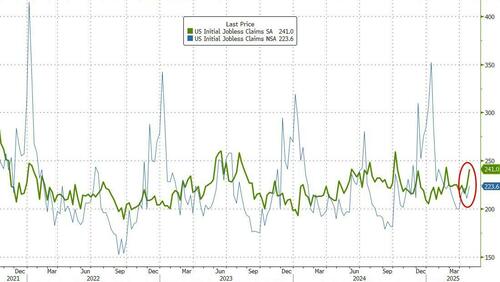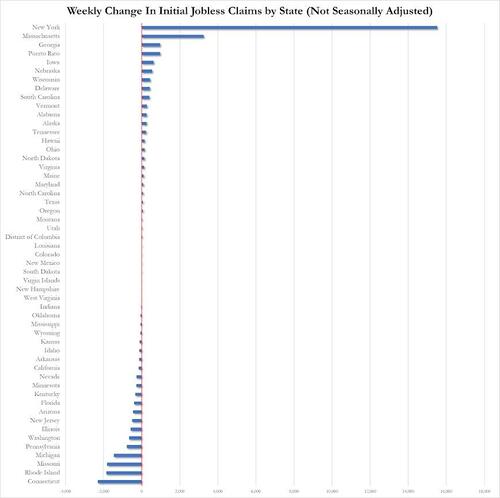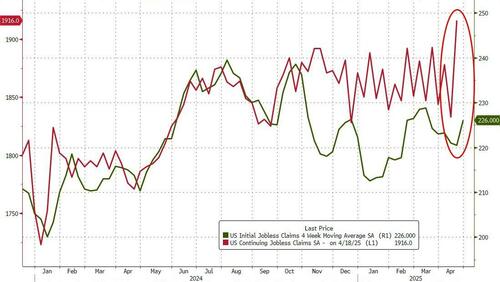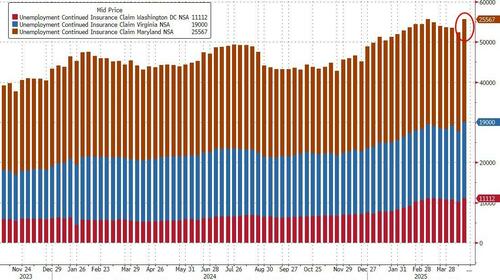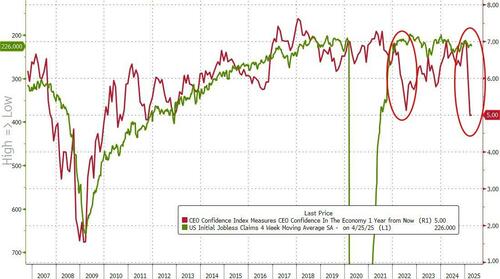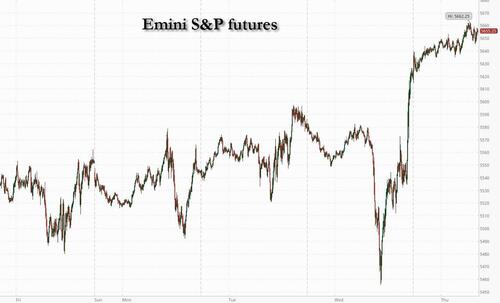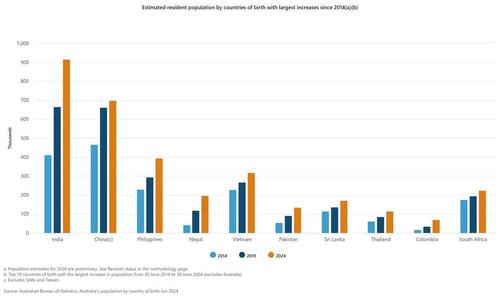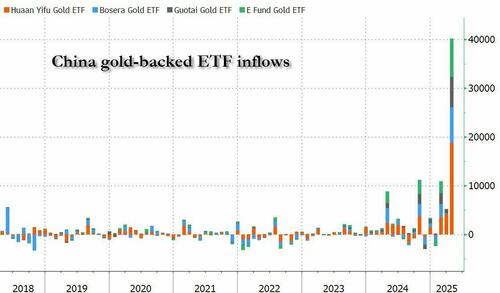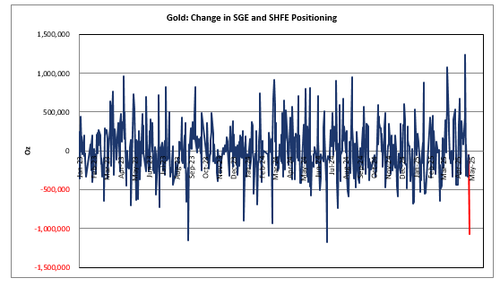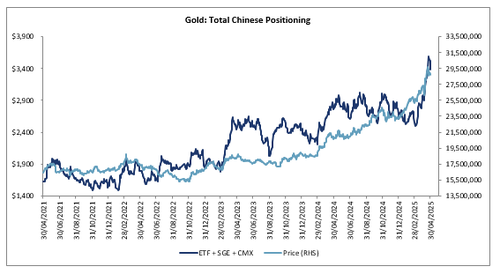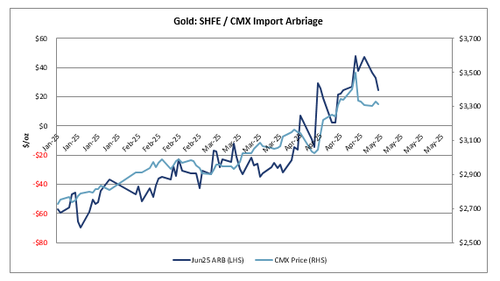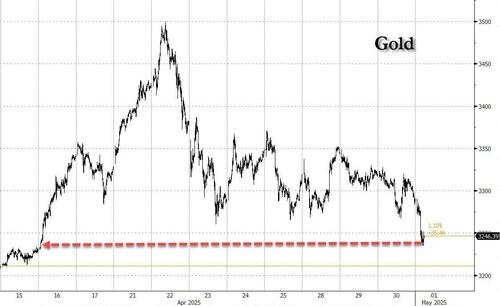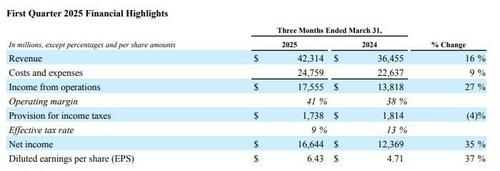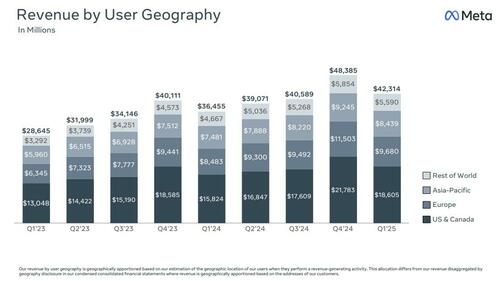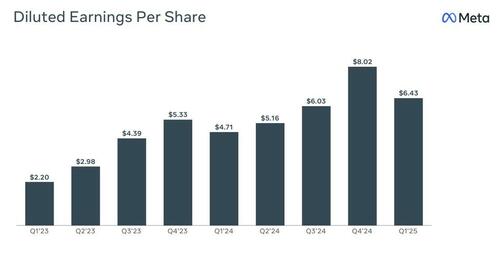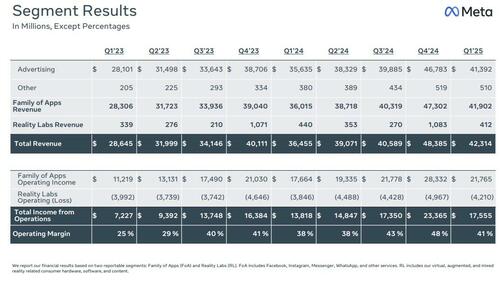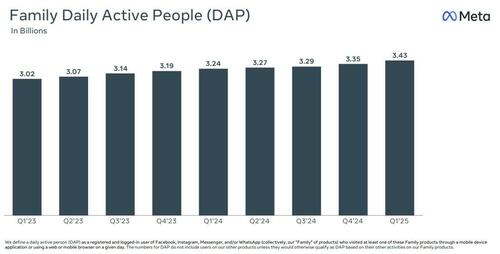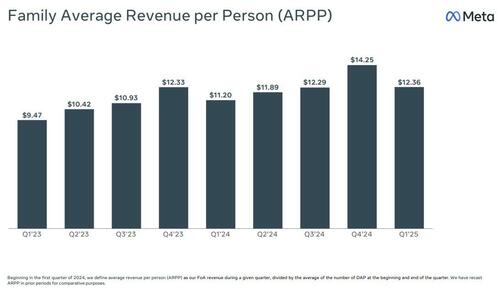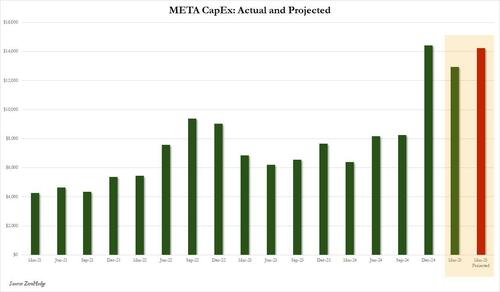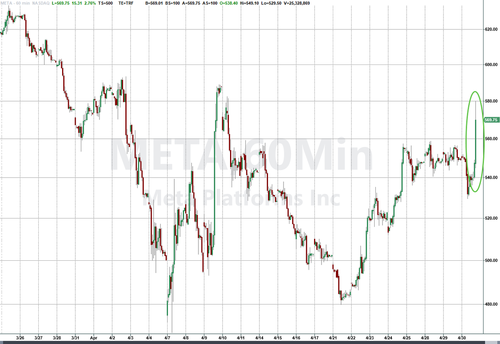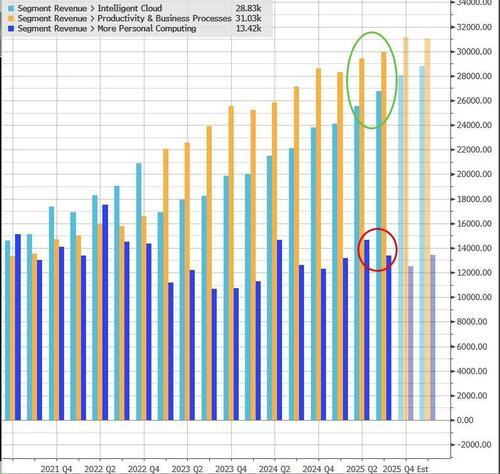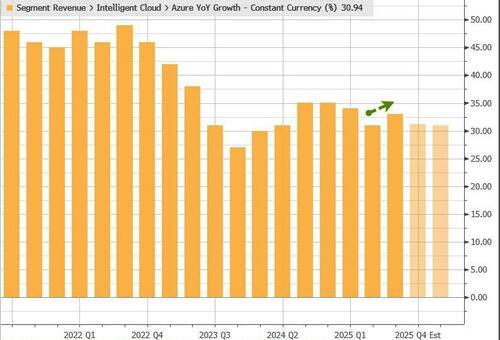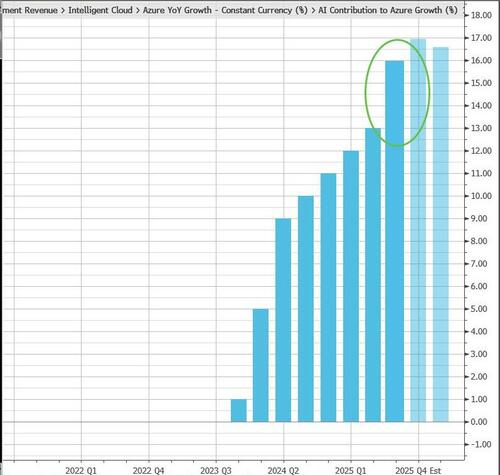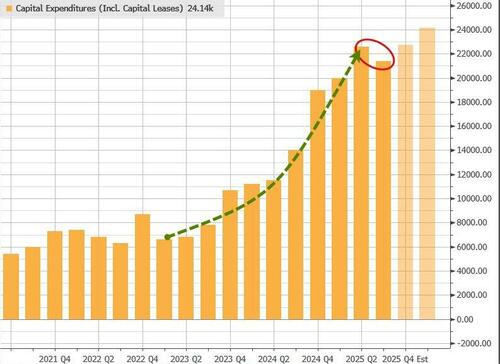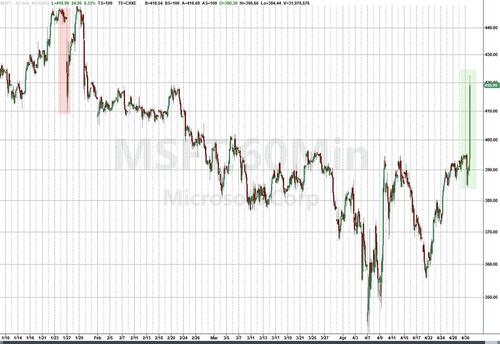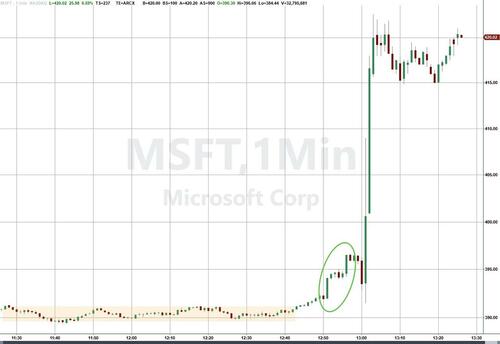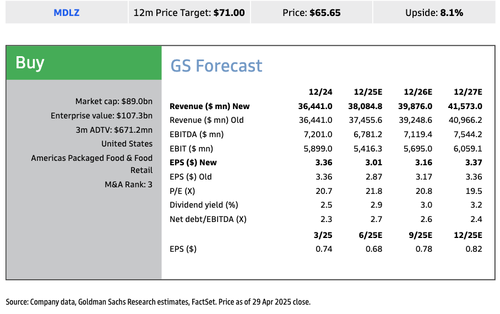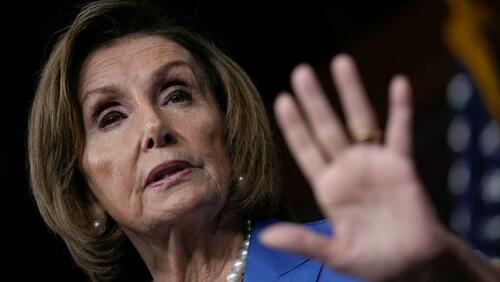That Christianity gives joy and breadth is also a thread that runs through my whole life. Ultimately someone who is always only in opposition could not endure life at all.
Distinction Matter - Subscribed Feeds
-
Site: Ron Paul Institute - Featured Articles
Last week the FBI arrested a Wisconsin state judge as she was walking into the courthouse where she works. The feds had alerted the media — but not the judge — to this event, and they arrived and recorded the arrest.
The standard and preferred practice when arresting a nonviolent person who is a public official with deep roots in the community is to invite the person to surrender with counsel.
Instead, without notice, this judge was stopped on a public street, handcuffed behind her back — a technique reserved for the most dangerous or threatening individuals — and within minutes, the FBI Director himself had posted still photos of this event on his X account.
The feds were unhappy at the manner in which a criminal defendant before this judge was permitted to leave her courtroom. By leaving through a nonpublic exit, instead of through the doors where the feds were awaiting him, his departure frustrated the feds who apparently expected the judge to accommodate them. The technical charge against the judge is obstructing the administration of justice. The true charge was failing to aid the feds.
Here is the backstory.
The feds have grown accustomed to commandeering the states to provide assistance when needed — and many states routinely complied. They did so either out of a sense of common purpose or because the feds had bailed them out financially.
Two Supreme Court cases, with largely compatible results, tested this relationship. The first, South Dakota v. Dole (1987), addressed the strings attached to the grants of federal funds to the states. Congress wanted to lower speed limits on highways and decided to bribe the states in order to achieve that goal. It offered huge amounts of cash for paving state and federal highways in return for reducing speed limits to 55 miles per hour.
When South Dakota told the feds that it would take the cash but not the lower speed limits, the Supreme Court ruled that so long as the strings attached to the financial grants are rationally related to the purpose of the grants, the strings are lawful and enforceable. So, South Dakota then took the cash and reluctantly lowered its speed limits.
Ten years later, Congress enacted gun regulations and ordered the states to enforce them. In a case called Printz v. United States (1997), the late Justice Antonin Scalia wrote for the Supreme Court that the states are still sovereign, they can reject federal cash and federal strings, and the feds cannot commandeer their officials. The federal government, the court held, is one of limited constitutional powers, and the power to commandeer state officials is not among them.
Both of these rulings unambiguously recognized the sovereignty of the states. The South Dakota case led to vastly more congressional bribery — the states today simply do not refuse federal cash. The Printz case led to federal frustration. That frustration boiled over outside a Wisconsin courthouse last week when the feds did what was surely unthinkable to Justice Scalia — arresting a sitting state judge who refused to be commandeered by the feds.
Judge Hannah Dugan was presiding over an arraignment for a non-incarcerated defendant when her court officers told her that the feds were in the courthouse hallway seeking to arrest the defendant in her courtroom, and the feds were growing impatient. When she asked to see their arrest warrant, they had none. Instead of an arrest warrant issued by a judge, as the Fourth Amendment requires, they presented an administrative warrant in which one federal agent authorizes another to arrest a person in a public place.
Judge Dugan shares the view of your author that the Fourth Amendment means what it says and thus administrative warrants are blatantly unconstitutional, and she would not recognize it. The purpose of the amendment is to ensure that only judges order arrests. When her business with the defendant in her courtroom was completed, she asked him to leave through the exit used by jurors, which was not accessible to the feds.
She did not inform the defendant that the feds were looking for him, but he apparently sensed that something was up; and when he left the courthouse and was met by feds who were waiting for him, he ran. A brief chase ensued, but the six feds captured the one defendant.
A week later, Judge Dugan was arrested for obstruction of justice.
Her arrest implicates not only the Supreme Court cases above — Wisconsin never agreed to have its officials assist the feds in immigration enforcement in return for federal cash, and the feds cannot commandeer state officials, judges or police, to assist them — as well as the recent Supreme Court decision on immunity. Though that case addresses presidential immunity, it is instructive on the nature of government in America. It teaches that government officials cannot be criminally prosecuted for the exercise of their core functions.
So, if the Secretary of Defense directs Air Force jets to attack a structure in a foreign country he mistakenly identifies as military but which turns out to be civilian, he cannot be prosecuted for homicide. If FBI agents raid and destroy the wrong house, they cannot be arrested for breaking and entering. And if a judge tells a defendant to leave her courtroom from door A and not door B, because behind B are folks with a phony warrant, she cannot be prosecuted.
This is bigger than Judge Dugan. We are witnessing an unprecedented assault on the separation of powers and the concept of federalism by a White House impatient with the constitutional process and largely indifferent to the role and function of the judiciary. The role of the judiciary is to be anti-democratic — to protect lives, liberties and properties from the other two branches.
If the feds succeed in intimidating judges and bending them to the presidential will, our liberties will have no protection.
To learn more about Judge Andrew Napolitano, visit https://JudgeNap.com.
COPYRIGHT 2025 ANDREW P. NAPOLITANO
DISTRIBUTED BY CREATORS.COM -
Site: RT - News
The US secretary of state highlighted the importance of the long-drafted agreement with Kiev as Washington negotiates with Moscow to end the conflict
The natural resource deal signed between Washington and Kiev is an “important step” toward ending the Ukraine conflict, US Secretary of State Marco Rubio has claimed.
The long-awaited agreement, which allows Washington to tap into Ukraine’s extensive mineral reserves in return for assistance with the country’s economic recovery, was signed on Wednesday.
Notably, the document does not include any provisions for the US to offer security guarantees to Ukraine, despite this being “one of its initial goals,” as reported by Reuters. The New York Times indicated that the concept of security guarantees was dismissed by the US “early in the process.”
In an X post on Thursday, Rubio thanked US President’s Donald Trump leadership, under which the deal was signed. Rubio called it “a milestone in our shared prosperity and an important step in ending this war.”
Thanks to @POTUS's leadership, today the U.S. and Ukraine signed the Reconstruction Investment Fund Agreement—a milestone in our shared prosperity and an important step in ending this war.
— Secretary Marco Rubio (@SecRubio) May 1, 2025Negotiations for the agreement stretched on for several months, although both parties intended to finalize it during Ukraine’s Vladimir Zelensky’s visit to the White House in late February. The televised meeting led to a tense confrontation during which Trump accused the Ukrainian leader of ingratitude and “gambling with World War III.”
Read more US-Ukraine resources deal: What we know so far
US-Ukraine resources deal: What we know so far
This comes as Washington is in talks with Moscow over a possible peace deal that would end the Ukraine conflict. Multiple media sources indicate that the agreement put forward by Washington entails the US recognizing Russia’s sovereignty over Crimea. Additionally, the proposal reportedly includes a “freezing” of the conflict along the existing front line and an acknowledgment of Moscow’s control over significant portions of four former Ukrainian regions that voted to join Russia.
Russian President Vladimir Putin ordered a halt to all military operations against Ukrainian forces from midnight on May 7 until midnight on May 10, stating that this is being done for “humanitarian reasons.” Russian Foreign Minister Sergey Lavrov pointed out that Russia considers the ceasefire “the start of direct negotiations with Kiev without preconditions.”
Zelensky branded Moscow’s three-day truce declaration a “manipulation attempt,” saying he wanted an immediate 30-day ceasefire instead. According to Lavrov, “a [30-day] ceasefire in this situation is considered a precondition that will be used to further support the Kiev regime and strengthen its military capabilities.”
-
Site: Zero HedgeKremlin Reacts To Minerals Deal Signing: 'Trump Has Broken The Zelensky Regime'Tyler Durden Thu, 05/01/2025 - 09:05
The Kremlin has said that what the newly signed minerals deal between Ukraine and Washington does is effectively force Kiev to pay for all future military aid.
"Trump has broken the Kyiv regime to the point where they will have to pay for U.S. aid with mineral resources," Medvedev, a former Russian president and current deputy chairman of Russia's Security Council, stated on Telegram.
 Treasury Secretary Scott Bessent and Ukrainian Economy Minister Yulia Svyrydenko sign the deal. US Department of the Treasury/Reuters
Treasury Secretary Scott Bessent and Ukrainian Economy Minister Yulia Svyrydenko sign the deal. US Department of the Treasury/Reuters
"Now they will have to pay for military supplies with the national wealth of a disappearing country," he said of the Ukrainians.
As of yet, the full contents of the newly inked deal, finalized and signed late in the day Wednesday, have not been revealed, but it gives the United States preferential access to new Ukrainian minerals deals and its natural resources like oil and gas, and will fund investment in Ukraine's reconstruction.
But the Zelensky government was able to get something crucial dropped at the last minute. As CNN details, "Compared to earlier drafts, the final agreement is reportedly less lopsided in favor of the US and is not as far-reaching. It stipulates that future American military assistance to Ukraine will count as part of the US investment into the fund, rather than calling for reimbursement for past assistance."
President Trump's initial reaction after the signing was seen in the following:
Speaking Wednesday in a call with NewsNation, Trump said he made the deal to “protect” Washington’s contribution to the Ukrainian war effort. “We made a deal today where we get, you know, much more in theory, than the $350 billion but I wanted to be protected,” Trump said.
“I didn’t want to be out there and look foolish,” he continued, voicing the administration's longtime complaints that Zelensky only asks for "more and more" - and yet is still losing the war.
Meanwhile, the ceasefire process is still basically stalled, as neither side has backed off of their demands and conditions. President Zelensky has recently reiterated that he can't even legally give up Crimea.
However, Trump presidential special envoy for Ukraine and Russia Keith Kellogg has told Fox News that Ukraine is ready to make territorial concessions, but wouldn't see any ceded territory as a permanent situion.
Treasury Secretary Scott Bessent says the signing of the "minerals deal" shows there is "no daylight" between the US and Ukraine. So that's a disappointment for anyone who might have wished for greater daylight between the US and Ukraine
— Michael Tracey (@mtracey) May 1, 2025"Not de jure forever, but de facto, because the Russians actually occupy that and they've agreed to that. They know that if they have a ceasefire in place, which means you sit on the ground that you currently hold, that's what they're willing to go to," the envoy said. "You have your line set, and they're willing to go there," Kellogg emphasized.
But it's clear the Kremlin sees this as an issue of sovereignty and permanence, given President Putin has described the four annexed territories and Crimea as "ours forever".
-
Site: Mises InstituteIn a libertarian world, the streets and highways would no longer be state-owned, but instead managed by private entities such as companies and cooperatives. How might this work?
-
Site: Mises InstituteIf we accept the Peronist views of the late pontiff, we obviously cannot support the marketplace. But fortunately, there is a better option available to us.
-
Site: Saint Louis Catholic
Waiting
Seeing
Praying
Let’s pray harder
St. Joseph Opificis, Terror of Demons and Protector of Holy Church, pray for us!
-
Site: PaulCraigRoberts.org
After 100 Days Where Are We?
Paul Craig Roberts
About a month or so ago on March 23 I posted on this website my memoir of my time in the Reagan administration which had just been published in The Independent Review, a readable quarterly. I expected to hear more than I did in response to my memoir, because I spelled out how difficult it is for a presidential appointee to actually support the policy of the President. https://www.paulcraigroberts.org/2025/03/23/my-time-in-the-reagan-administration/
Then it occurred to me that the Reagan administration was a long time ago, 1981-1988. President Reagan’s term ended 37 years ago. So an American 50 years old today was 13 years old when Reagan’s second term ended. He was 5 years old when Reagan was elected president. A 50 year old American never experienced the Reagan administration. A 60 year old American was only 15 when Reagan took office. The vast majority of Americans alive today know nothing of the Reagan administration except the accounts of the presstitute media and historians grinding ideological axes. Yet, somehow, Americans say they miss Reagan, the last American president.
With Trump’s first 100 days behind us, MAGA Americans are touting his successes and the Democrats are multiplying his “failures.”
Let me tell you about a real successful president–Ronald Reagan–Perhaps the only successful president in the 20th century. Reagan had two major successes. I know because I was part of them. Reagan cured stagflation–the simultaneous rise of inflation and unemployment– with his supply-side policy, and he ended the Cold War with the Soviet Union. Tell me, what American president has had such extraordinary successes?
Reagan’s success was covered up with media hype about “the teflon President,” with the neoconservatives’s Iran/Contra scandal, with “the Reagan deficits” that belong to David Stockman and Paul Volcker.
American historians, academics who guarantee their careers by justifying the various atrocities their governments commit, rank the top five US presidents as Abraham Lincoln, George Washington, Franklin D. Roosevelt, Theodore Roosevelt, and Dwight D. Eisenhower in that order. https://www.c-span.org/presidentsurvey2021/?page=overall
Lincoln destroyed the Constitutional framework based on states’ rights as designed by the Founding Fathers. Lincoln introduced war against civilians as an essential part of war against the opposing army. Today the International Criminal Court would recognize Lincoln as a war criminal and issue arrest warrants.
Thomas Jefferson, who wrote the Declaration of Independence, ranks 7 after Harry S. Truman, who nuked two Japanese civilian cities while the Japanese government was pleading with Washington for peace.
John F. Kennedy comes in 8th, Ronald Reagan 9th, Barack Obama, who bombed 7 countries comes in 10th, and President Lyndon Johnson–“LBJ, LBJ, How Many Kids Did You Kill Today”–comes in 11th.
What we see here are the liberals, not willing to dethrone the first American president, or a Founding Father who wrote the Declaration of Independence, or John F. Kennedy a martyr, or Reagan whose popularity remains high, shielding themselves from partisanship by including Jefferson, Kennedy, and Reagan in the second tier of successful presidents..
Lincoln destroyed the US Constitution which is based on states rights. He conducted a war of war crimes against an agricultural society that could not afford to pay the Morrill Tariff in order to industrialize the North at the expense of the South. No sooner than the South was destroyed, the Union launched a war of extermination against the native American Plains Indians, the same Union Generals–Sherman and Sheridan–the same Union soldiers that raped and pillaged the South repeated the application to the remaining Native Americans. As Lincoln’s reward for genocide, he is voted by American historians as the best ever–the Number One-of all American presidents.
Franklin D. Roosevelt gets the third ranking, because he replaced the power of Congress with the power of regulatory agencies.
Theodore Roosevelt is bestowed the 4th ranking because he established the American policy of empire and hegemony.
One assumes Eisenhower’s fifth rank is because he is alleged to have won World War II for the US.
Truman is 6th because he nuked Japan, thus putting the Soviet Union on notice.
If you look at these achievements, Washington and Jefferson, aside, Ronald Reagan at number 9 on the list is the only one who rescued America from an economic catastrophe and a Cold War that could have turned hot.
Liberals and what passes for a left-wing say that Reagan was just another fake, another warmonger committed to the Soviet Union’s destruction. But a president who was a fake would never, ever, put me in charge of his economic policy, nor would he appoint me to a secret presidential committee to verity or disprove the CIA’s argument against ending the Cold War. I am the last person on earth that a fake President wants to hand a Presidential Appointment or a decision on a critical foreign policy issue.
So, now that we have all of the congratulatory and denunciatory accounts of Trump’s 100 Days, what do they mean?
Trump did a good thing in service to justice when he pardoned and released from prison the framed-up-by-the-Biden-anti-American-regime American citizens who used their Constitutional rights to protest a stolen presidential election. But the corrupt persons who framed up innocent Americans have not been arrested and indicted, as they should be. Why is Trump focused on Ukraine rather than on those who framed innocent Americans as “insurrectionists”?
The Democrats have shown that they will strongly resist Trump’s rollback of the legal privileges Democrats created for DEI-designated-persons and for immigrant-invaders. Democrat district court judges, the lowest of the low, have claimed the right to decide the power of the President of the United States to govern. Trump’s reply is that he abides by judicial rulings. Trump is relying on the Supreme Court to overturn the district courts, but if that doesn’t happen, will Trump fight?
Trump himself makes deals with Zelensky and claims they are deals Putin must accept. This is nonsensical. The conflict is between the US and Russia. The deal has to be made between Trump and Putin.
The real problem is the neoconservative doctrine of American hegemony As long as American foreign policy is based on Paul Wolfwitz’s doctrine, there can be no peace.
Trump has not repudiated the doctrine of American hegemony. Until he does, how can Putin trust him?
-
Site: PaulCraigRoberts.org
Is the Purpose of the Peace Negotiations to Sequence the West’s Wars with Russia and China?
Paul Craig Roberts
President Putin’s National Security Advisor Nikolay Patrushev recently stated that, Ukraine negotiations notwithstanding, the West is “deploying their military machine against Russia and becoming delirious with nuclear apocalypse scenarios.”
”For a second consecutive year, NATO is conducting exercises at our borders at a scale unseen in decades,” Patrushev said. “They are training for conducting a broad offensive from Vilnius to Odessa, seizing [the Russian exclave] Kaliningrad Region, imposing a naval blockade in the Baltic and the Black Seas, and executing preventive strikes on the staging locations of Russian nuclear deterrence forces.”
https://www.rt.com/russia/616473-patrushev-nuclear-conflict-west/
Reports are emerging from Russia that Putin wants a Ukrainian settlement so that Russia can prepare for a war that the West is bringing to Russia in three years when the British, French, Poles, and Germans are prepared. Putin wants to disengage from Ukraine in order to prepare for the real thing.
If Israel succeeds in getting Trump to attack Iran, the timetable will be thrown off.
Unless President Trump and the US Congress renounce US hegemony and declare America’s independence from Israel, no peace is possible.
I discuss with Nima on Dialogue Works whether the “peace negotiations” are a technique to move Russia aside while Washington takes on China: https://www.youtube.com/live/9DqDUqoVZI0
-
Site: PaulCraigRoberts.org
Weaponizing Anti-Semitism
The Jew cries out in pain as he strikes you.
Polish proverbBritish Labour Leader Jeremy Corbyn was removed by anti-semitism accusations.
Jewish journalist Simon Heffer announced on radio that Corbyn “wanted to re-open Auschwitz.”
British PM Starmer’s “first act as Labour leader was not to address the conditions of the working class, but to reassure “the Israel Lobby that they were back in the driver’s seat.”
Starmer invited an Israeli spy to head British surveillance of citizens on social media. The anti-semitism cases brought against British citizens are now prepared by an Israeli.
Free speech originated in Britain, and it has died there. British citizens can no longer make any critical remark that pertains to Jews, Muslims, Arabs, blacks, or Asians unless they are Chinese, Japanese, or North Koreans.
President Trump is now applying the same standard to American universities and their students. Leaders such as Starmer and Trump who do not respect free speech do not respect democracy.
https://www.unz.com/article/trial-by-jewry-asa-winstanley-on-weaponizing-anti-semitism/
-
Site: Catholic Herald
Every so often there comes a moment in history when the world’s entire attention is focused on a particular event or person – the death of a pope is one such example. When Pope Francis appeared to give Urbi et Orbi on Easter morning, and to be driven around St Peter’s Square for what would be the final time, he looked so unwell that it seemed obvious that he would not live much longer. With impeccable timing, which could hardly have been more dramatic, he died that night; the last act of this Servant of the Servants of God was to impart his apostolic benediction to Rome and the world beyond its gates.
The response to his death has been remarkable; an international outpouring of tangible grief accompanied by a generally sincere yearning for information. Very quickly requests arrived for interviews from local and international broadcasters – from the UK, Australia and the United States. I did my best to accept as many as possible, and found the experience extremely varied. As we have covered online and in these pages, Pope Francis’s character was a fascinating combination of openness and inscrutability – and occasionally of contradiction, too. For many of my interlocutors this seemed to come as something of a surprise.
Meanwhile, with my historian’s hat on, what was particularly fascinating was the response of the British establishment. The King – the Supreme Governor of the Church of England, and successor of Henry VIII – released a heartfelt tribute and conducted official engagements in mourning dress. Flags were flown at half-mast on government buildings, as indeed they also were in the United States. Meanwhile, the Archbishop of York – both the papacy and the See of Canterbury are simultaneously vacant for the first time since 1691 – publicly prayed for the repose of Pope Francis’s soul. What was that about a Reformation?
The reaction online, in an arena that Pope Francis inhabited so effectively, was immediate; so too was the speculation, sometimes frenzied and in many cases perhaps rather too soon for good taste, about who his successor might be.
The Guardian reported that online viewing of Edward Berger’s recent film Conclave, which won best picture at the Baftas and was nominated for eight Oscars, soared by 283 per cent in the days following his death.
As this month’s May edition of the Catholic Herald magazine went to press, the focus in Rome was on the lying-in-state and the papal funeral; very soon it will shift to the conclave, and by the June issue we will almost certainly know who will come next. We will know, too, what his papacy will be like from the moment his name is announced by the senior cardinal deacon: Francis II? Benedict XVII? John Paul III? Pius XIII has surely been ruled out by Jude Law in The Young Pope.
The betting shops wasted no time in publishing their odds, either. Placing a wager on the outcome of a conclave used to be an excommunicable offence, but names have risen and fallen in the rankings like horses at the Derby – some of the touted papabili found themselves mobbed like celebrities in the streets of Rome. Will the next pope come from Asia or Africa? Will the electors think that after five decades, it is time for an Italian to be Bishop of Rome? Will he be well known, like some of the prefects of dicasteries, or from the peripheries of the Church, which Pope Francis loved so well? At the time of writing, God alone knows.
What is certain, however, is that he will have his work cut out. Among other things, whoever appears on the balcony of St Peter’s Basilica in due course will have to contend with the near-collapse of the Church in her traditional heartlands, bring peace once more in the liturgy wars, continue to work on reforming the Vatican’s finances, and move heaven and earth to tackle decisively and effectively the suppurating scandal of abuse. And all this he must do as a febrile world teeters on the edge of further violence and instability – as if personal responsibility for 1.4 billion souls were not already burden enough.
Photo: Pope Francis prays in front of the statue of the Immaculate Conceptionon at Spanish Steps, Rome, Italy, 8 December 2013. Following a tradition laid out by his predecessors, Pope Francis celebrated the Feast of the Immaculate Conception by travelling to Spanish Steps where he venerated the statue named for the Marian Feast. The statue of the Immaculate Conception was consecrated on 8 December 1857, several years after the dogma which states that Mary was conceived without the stain of original sin was adopted by the Church. (Photo by Franco Origlia/Getty Images.)
This article appears in the May 2025 edition of the Catholic Herald. To subscribe to our thought-provoking magazine and have independent, high-calibre and counter-cultural Catholic journalism delivered to your door anywhere in the world click HERE.

The post Taking personal responsibility for 1.4 billion souls: the spectacle gripping the world first appeared on Catholic Herald.
The post Taking personal responsibility for 1.4 billion souls: the spectacle gripping the world appeared first on Catholic Herald.
-
Site: Zero HedgeJobless Claims Jumped Last Week As 'DOGE Actions' Spark Biggest YTD Layoffs Since 2020Tyler Durden Thu, 05/01/2025 - 08:39
So far this year, employers have announced 602,493, the highest year-to-date total since 2020 when 1,017,812 job cuts were recorded, according to the latest data from global outplacement and executive coaching firm Challenger, Gray & Christmas.
It is up 87% from the 322,043 cuts announced during the same period in 2024.
The Government leads all sectors in job cuts this year with 282,227; 281,452 of which are attributed to DOGE-related cost-cutting.
This is up 680% from the 36,195 job cuts announced in this sector through April 2024. In April, the number of job cuts announced in this industry was 2,782. DOGE actions were attributed to 2,731, while the rest were attributed to “Economic Conditions” and “Cost-Cutting.”
-
“DOGE Actions” lead all job cut reasons in 2025 with 283,172; 2,919 of which occurred in April. Another 6,945 cuts were attributed to “DOGE Downstream Impact” through April, primarily at Non-Profits and Education organizations. These reasons combined (290,117) make up 48% of all job cuts announced so far in 2025.
-
Market/Economic Conditions were cited for 95,348 job cuts, as economic uncertainty, consumer spending, and trade difficulties impact US-companies.
Tariffs were cited for 1,413 cuts so far this year, with 1,350 occurring in April. Restructuring accounted for 67,627, and 60,551 were due to store, unit, or location “Closing.”
This weak labor market data comes on the heels of yesterday's dismal ADP Employment report.
This morning we see initial jobless claims jump notably too - to 241k (higher than the 223k expected). While not out of recent norms, this is a sizable jump...
Source: Bloomberg
Interestingly, New York dominated the surge in initial claims...
Continuing jobless claims also surged last week, back above 1.9 million Americans - its highest since Nov 2021...
Continuing claims for the 'Deep TriState' rose significantly last week...
Source: Bloomberg
As SouthBay Research highlights, the ~80K jump in Continuing Claims is relatively broad, with core drivers being New York (+14K), California (+9K), Connecticut (+5K), New Jersey (+4K), Texas (+6K).
This most definitely points to economic headwinds translating into lower payrolls.
While the 1-week 80K jump stems mainly from the seasonal adjustments (Non Seasonally Adjusted Continuing Claims rose 26K), it clearly points to lower hiring underway in the first 2-weeks of April. Precisely when the Nonfarm Payroll Survey was done.
Still, in context, it seems CEOs are all willing to whine about the economy but their actions speak louder than their words...
“Though the Government cuts are front and center, we saw job cuts across sectors last month. Generally, companies are citing the economy and new technology. Employers are slow to hire and limiting hiring plans as they wait and see what will happen with trade, supply chain, and consumer spending,” Andrew Challenger, Senior Vice President and workplace expert for Challenger, Gray & Christmas.
...and none of this is a good sign for tomorrow's all-important payrolls print.
-
-
Site: Zero HedgeUS Futures Surge On Blowout Tech Earnings, Erasing April's LossesTyler Durden Thu, 05/01/2025 - 08:26
US equity futures are sharply higher, erasing all of April's losses on blowout earnings from MSFT and META, and relief over signs the Trump administration is stepping back from its harshest tariff threats. As of 8:00am ET, S&P futures rose 1.2% to 5655, the highest level since before Trump's Liberation Day announcement and pointing to an eighth consecutive session of gains for the cash index; Nasdaq futures gained 1.7%, as META and MSFT added +6.3% and +7.8%, respectively; most Mag 7 names, NVDA (3.7%) and semis are higher given META’s CapEx increase and MSFT’s reiteration on CapEx guidance. The dollar is higher after the BOJ finally flipped dovish and slashed its growth target pushing USDJPY to 144.5 this morning. It's light on overnight news as most of Europe is closed today ex-UK along with China; US/Ukraine signed an agreement over the country’s natural resources, UK Manf PMI printed better but remained in contraction, and Trump reiterated that there is a “very good chance” of a deal with China on NewsNation last night. Commodities are mostly lower: WTI -1.2%; Gold -1.7%. The US economic calendar includes weekly jobless claims (8:30am), April manufacturing PMI (9:45am), ISM manufacturing and March construction spending (10am). Fed’s external communications blackout ahead of the May 7 FOMC meeting. Apple and Amazon results are due after the market close.
In premarket trading, the Magnificent Seven are mostly higher: Microsoft (MSFT) gains 8% after the company reported stronger-than-expected quarterly sales and profit growth. Meta (META) jumps 6% after the company’s advertising sales quelled Wall Street concerns about the impact of the Trump administration’s trade war. Apple was the only tech giant in the red, falling 1.4% after a federal judge said in a ruling that it violated a court order requiring it to open up the App Store to third-party payment options (other Mag7s are up Nvidia +4.6%, Amazon +3.7%, Alphabet +1%, Tesla +0.7%).
McDonald’s Corp. (MCD) declines 1.4% as sales fell in the first quarter, reflecting a deterioration in consumer sentiment that’s making it harder for restaurants to lure in diners. Eli Lilly & Co. (LLY) drops 5% after the company cut its earnings outlook. Here are some other notable premarket movers:- Align Technology rises 10% after the Invisalign company reported quarterly shipments that beat the average analyst estimate.
- Confluent Inc. falls 10% after the provider of a streaming platform gave an outlook for second-quarter subscription revenue that fell shy of expectations. First quarter results showed a slowdown in additions of customers with $100,000 in annual recurring revenue.
- CVS Health rises 8% after the company boosted its adjusted earnings per-share-guidance for the full year and reported better-than-expected results for the first quarter
- E2open shares are up 34% after WiseTech Global, in response to media reports about its being in discussions to acquire E2open, said it was participating in a strategic review process.
- KKR & Co. rises 2% after the investment firm reported assets under management that beat the average analyst estimate. Fee-related earnings also came in above analysts’ expectations.
- Qualcomm falls 5% as the biggest maker of chips that run smartphones gave a tepid revenue prediction for the current quarter, underscoring concerns that tariffs will hurt demand for its products.
- Robinhood gains 4% after the trading platform’s earnings largely beat expectations, with analysts highlighting positive trends in April amid market volatility and a boost from a lower tax rate.
- Shake Shack falls 3% after posting first-quarter results.
- Wayfair gains 5% after posting adjusted earnings per share for the first quarter that beat the average analyst estimate.
Tech giants added to investor optimism that deals between the US and its partners would limit the damage from Trump’s trade war. Wall Street ended a tumultuous month on a day in which the S&P 500 erased an intraday drop of more than 2% to close 0.2% higher. Traders sought reassurance in bets on Federal Reserve easing after the US economy contracted for the first time since 2022.
“So far we’re seeing big tech companies deliver on earnings, which is reassuring, and it’s this reassurance which is supporting equity market futures,” said Georgios Leontaris, chief investment officer for EMEA at HSBC Global Private Banking. “The other element of the story beyond earnings is obviously the ongoing debate as to whether we’ve seen peak tariff noise or not.”
Apple results are due after the market close. Analysts will be listening closely for any further detail on how the company, whose supply chain is reliant on China, Vietnam, and India, views the impact of tariffs
The White House said it was nearing an announcement of a first tranche of trade deals with partners that would reduce planned tariffs. Sentiment was also helped by a report that the US has been proactively reaching out to China through various channels. At the same time, Trump said he would not rush deals to appease nervous investors.
The US and Ukraine reached a deal over access to the country’s natural resources, offering a measure of assurance to officials in Kyiv who had feared Trump would pull back his support in peace talks with Russia.
Elsewhere, most markets in Europe and many in Asia are shut for holidays. The UK’s FTSE 100 index was steady, following 13 days of gains, the longest winning streak since 2017. Gains in material and industrial names are offset by losses in energy and health care.
In FX, the Bloomberg Dollar Spot Index rises 0.3%. the yen is the weakest of the G-10 currencies, falling 0.9% against the greenback after the Bank of Japan pushed back the timing for when it expects to reach its inflation target and slashed its growth forecasts. The pound and euro are little changed.
In rates, treasuries climb, pushing US 10-year yields down 2 bp to 4.14%. Treasury spreads remain within a basis point of Wednesday’s close, as gains remain broad-based across the curve. Gilts are steady, with UK 10-year borrowing costs flat at 4.44%. Treasury futures edge higher into the early US session, on the day’s highs with yields lower by 1bp to 2bp across the curve. US session focus includes weekly jobless claims along with both ISM and PMI manufacturing reports.
In commodities, oil prices decline, with WTI falling 2.3% to below $57 a barrel; the drop followed the biggest monthly drop since 2021, as signs that the Saudi-led OPEC+ alliance may be entering a prolonged period of higher output added to concerns the trade war will hurt demand. Spot gold is down $65 at $3,223/oz, falling for a third day on signs of potential trade-talk progress between the US and several other nations, quelling demand for havens even as signs of slowdowns have emerged in the largest economies. Bitcoin rises 1% and above $95,000.
Looking at today's calendar, we get the April Challenger job cuts (7:30am), weekly jobless claims (8:30am), April manufacturing PMI (9:45am), ISM manufacturing and March construction spending (10am). Fed’s external communications blackout ahead of the May 7 FOMC meeting
Market Snapshot
- S&P 500 mini +1.2%
- Nasdaq 100 mini +1.6%
- Russell 2000 mini +0.3%
- Stoxx Europe 600 little changed
- DAX +0.3%
- CAC 40 +0.5%
- 10-year Treasury yield -2 basis points at 4.15%
- VIX -0.9 points at 23.85
- Bloomberg Dollar Index +0.2% at 1226.38
- euro little changed at $1.1324
- WTI crude -2% at $57.02/barrel
Top Overnight news
- The US and Ukraine signed an agreement over access to the country’s natural resources. The deal will see the US will get first claim on profits transferred into a jointly managed investment fund that’s intended in part to reimburse the US for future military assistance. BBG
- House Republicans are seriously considering proposals to further limit tax deductions that companies can take for their highest-paid workers’ compensation, expanding restrictions that now apply only to a handful of current or former executives making more than $1 million, according to people familiar with the discussions. WSJ
- US President Trump said we are going to have 'Made in the USA' like never before and he stated give us a little time to get moving regarding the economy. Furthermore, Trump said interest rates should go down and reiterated that "he (Powell) should reduce interest rates, I understand them better than him", as well as noted it would be nice for people wanting to buy homes and things.
- There was some chatter that the House Ways and Means Committee is going to mark up their tax package on May 8th: Punchbowl.
- Elon Musk said he’s considering sending DOGE to the Fed, citing a costly renovation of its headquarters as an example of potential government waste. BBG
- The yen dropped as much as 1.2% after the BOJ pushed back the timing for when it expects to reach its inflation target and Governor Kazuo Ueda spoke of uncertainties due to tariffs. For now, policymakers kept rates at 0.5%. BBG
- China feels the white house is “too divided” on trade policy and will hold off on entering serious trade talks with the US while it waits to see which of Trump’s advisors will have his ear and how other countries respond to the 90 day pause on tariffs. SCMP
- Saudi Arabian officials are briefing allies and industry experts to say the kingdom is unwilling to prop up the oil market with further supply cuts and can handle a prolonged period of low prices, five sources with knowledge of the talks said. This possible shift in Saudi policy could suggest a move toward producing more and expanding its market share, a major change after five years spent balancing the market through deep output as a leader of the OPEC+ group of oil producers. RTRS
- The EU is planning to share a paper with the US next week that will set out a package of proposals to kick-start trade negotiations with the Trump administration. The paper will propose lowering trade and non-tariff barriers, boosting European investments in the US, cooperating on global challenges such as tackling China’s steel overcapacity and purchasing US goods like liquefied natural gas and technologies. BBG
- Janet Yellen has warned that Trump’s tariffs will have a “tremendously adverse” impact on the US economy as they “hobble” companies that rely on critical mineral supplies from China. She added: “I’m not yet ready to say that I’m forecasting a recession, but certainly the odds have gone way up. FT
- Microsoft beat estimates and showed strong growth in its key Azure cloud business, while Meta also topped estimates and raised its full-year capex forecast as it continues to invest in AI. With first-quarter earnings in full swing the scorecard so far has shown resilience amid Trump’s trade war. The next big test comes after the close, when Apple and Amazon report. BBG
Tariffs/Trade
- US President Trump reiterated there is a very good chance that they will make a deal with China and any deal has to be on their terms, while he added that they are negotiating with India, South Korea and Japan.
- US President Trump said after a certain amount of time, there will be a tariff wall for pharmaceutical companies.
- USTR Greer said it is a matter of weeks not months to have initial trade deals announced and he is meeting with Japan, Guyana and Saudi Arabia on Thursday and with the Philippines on Friday. Greer added he wouldn't say they are 'finish-line' close on an India trade deal but noted he has a standing call with India's Trade Minister and said they are working closely with the UK and moving quickly with countries ready to move forward on trade. Furthermore, Greer said Canadian PM Carney is a serious person and that President Trump wants a healthy relationship in North America, while he added there are no official talks with China yet and that harmful foreign trade practices, including those in China, need to be addressed.
- China is to hold off on entering serious trade discussions with the US while it waits to see which of US President Trump’s advisers will have his ear and how other countries will respond to the 90-day pause on tariffs, according to a source cited by SCMP
- US Senate narrowly rejected a bipartisan measure to block Trump tariffs with the vote count at 49-49.
Notable Earnings
- eBay Inc (EBAY): Shares +0.5% pre-market. Q1 profit beat estimates, and revenue also increased. The company announced that Peggy Alford was appointed CFO, replacing Steve Priest, as the company adjusts its leadership. It reported Q1 adj. EPS of 1.38 (exp. 1.34), Q1 revenue of USD 2.6bln (exp. 2.55bln). Q1 gross merchandise volume USD 18.75bln (exp. 18.52bln); International GMV USD 9.69bln (exp. 9.58bln); US GMV USD 9.07bln (exp. 8.92bln). In Q1, it had 134mln active buyers (exp. 134.17mln). Sees Q2 revenue between USD 2.59-2.66bln (exp. 2.60bln), and sees Q2 adj. EPS between 1.24-1.31 (exp. 1.29). (Newswires)
- Meta Platforms (META) - Shares +6.5% pre-market following a Q1 beat, while Q2 guidance was in line with expectations. Q1 revenue rose +16% to USD 42.31bln (exp. USD 41.4bln), with EPS of USD 6.43 (exp. USD 5.28); Q1 advertising sales were USD 41.39bln (exp. 40.55bln). Exec said daily users reached 3.43bln, while Threads has now has more than 350mln monthly active users. FY25 CapEx guidance was increased to USD 64–72bn for 2025 (prev. saw 60-65bln), and exec said that increased CapEx will bring data centre capacity online quicker. On AI, exec said its Meta AI app is focused on scaling and engagement this year, with business integration planned for next year; nearly 1bln monthly active users now use Meta AI across its apps. Exec also said that the EC's ruling may hit its EU business, where it will need to make modifications to ads model which could have significant impact to European business and revenue as early as Q3, while Asia ad spend fell amid regulatory uncertainty. Sees Q2 revenue between USD 42.5bln-45.5bln (exp. 44.41bln), lowered its FY25 total expenses view to USD 113bln-118bln (prev. saw 114-119bln). (Newswires)
- Microsoft (MSFT) - Shares +8.1% pre-market following a beat on Q3 sales and profits, driven by 20% cloud growth amid strong AI demand. The tech giant reported Q3 adj. EPS of 3.46 (exp. 3.21), Q3 revenue USD 70.1bln (exp. 68.41bln); Q3 CapEx USD 16.75bln (exp. 16.28bln). Azure and other cloud services revenue (Ex-FX) surged +33% (exp. +31%), with Azure growth attributable to AI 16pts (exp. 15.6ppts); the majority of Azure outperformance in Q3 was in its non-AI business. Q3 Cloud sales USD 42.4bln (exp. 42.22bln), Q3 Intelligent Cloud sales USD 26.8bln (exp. 25.99bln). Exec said H2 total CapEx view remains unchanged vs January guidance. Sees Q4 revenue between 73.3bln-73.4bln (exp. 72.0bln), Q4 CapEx expected to increase on a sequential basis, Q4 cloud gross margin expected to be 67% (down Y/Y), Q4 Intelligent Cloud revenue seen between USD 28.75bln-29.05bln (exp. 28.52bln), while Q4 Azure and other cloud services revenue growth is expected to be 34-35% in constant currency. Exec said that FY26 CapEx is expected to grow at a lower rate than FY25. (Newswires)
- Qualcomm (QCOM) - Shares +5.7% pre-market after it topped Q2 top- and bottom-line estimates, but Q3 guidance was light, and it sees a sales hit from US tariffs ahead. It reported Q2 adj. EPS 2.85 (exp. 2.80), Q2 revenue USD 10.84bln (exp. 10.60bln); Q2 QCT revenue USD 9.47bln (exp. 9.23bln), Q2 QTL revenue USD 1.32bln (exp. 1.35bln); Q2 Internet of Things revenue USD 1.58bln (exp. 1.45bln), Handsets revenue USD 6.93bln (exp. 6.84bln), Automotive revenue USD 959mln (exp. 909.8mln). Sees Q3 adj. EPS 2.60-2.80 (exp. 2.66), Q3 revenue between USD 9.9-10.7bln (exp. 10.33bln), sees Q3 QCT revenue between USD 8.7-9.3bln (exp. 8.98bln), and sees Q3 QTL revenue between 1.15-1.35bln (exp. 1.3bln). (Newswires)
A more detailed look at global markets courtesy of Newquawk
APAC stocks traded higher but with gains capped in severely thinned conditions owing to mass holiday closures across the region and in Europe for Labour Day. ASX 200 eked mild gains as the outperformance in tech, real estate and consumer staples was offset by losses across the commodity-related sectors, while trade data was mixed as Australian monthly exports returned to growth but imports contracted. Nikkei 225 advanced at the open after having reclaimed the 36,000 level and with further upside seen after the BoJ policy announcement where the central bank kept rates unchanged at 0.50% and provided some dovish rhetoric despite maintaining its rate hike signal.
Top Asian News
- BoJ maintained its short-term interest rate target at 0.5%, as expected, with the decision made by unanimous vote, while it said it will continue to raise the policy rate if the economy and prices move in line with its forecast and will conduct monetary policy appropriately from the perspective of sustainably and stably achieving the 2% inflation target. BoJ said Japan's economic growth is likely to moderate and underlying consumer inflation is likely to be at a level generally consistent with the 2% target in the second half of the projection period from fiscal 2025 through 2027, as well as noted that uncertainty surrounding Japan's economy and prices remains high with risks to the economic outlook and inflation outlook are skewed to the downside. Furthermore, it lowered its evaluation of the economic outlook and warned that a prolonged period of high uncertainties regarding trade and other policies could lead firms to focus more on cost-cutting, and as a result, moves to reflect price rises in wages could also weaken. In terms of the Outlook Report projections, the Real GDP median forecast for Fiscal 2025 was cut to 0.5% from 1.1% and the Fiscal 2026 estimate was cut to 0.7% from 1.0%, while the Core CPI median forecast for Fiscal 2025 was cut to 2.2% from 2.4% and the Fiscal 2026 forecast was cut to 1.7% from 2.0%.
- BoJ's Ueda Press Conference: Uncertainty from trade policy has heightened sharply. Expect to keep raising rates if the economy and prices move as projected. Timing to attain the underlying 2% inflation target will be delayed. Price goal timing delay doesn't mean delay in hikes; timing of trend inflation does not necessarily correlate with the timing of a hike.
Due to Labour Day across Europe, cash and derivatives markets are closed across Euronext services and those run by other European exchanges such as Deutsche Boerse, SIX and Nasdaq (Scandinavia closed ex-Copenhagen). The UK’s FTSE 100 is one of the few indices in Europe which is open today; currently flat.
Top European news
- EU is to present trade proposals to the US next week, according to Bloomberg citing officials.
FX
- DXY is up for a third consecutive session with the USD firmer vs. all major peers. On the trade front, the White House administration continues to talk up the possibilities of imminent trade deals. Reports suggest that the US reached out to China recently for tariff talks. However, Chinese press notes that China is to hold off on entering serious trade discussions with the US while it waits to see which of US President Trump’s advisers will have his ear and how other countries will respond to the 90-day pause on tariffs. Ahead, Challenger layoffs, weekly claims and ISM manufacturing PMI are all due. DXY ventured as high as 100.08, but has recently waned off that high to a current 99.75 level.
- EUR is essentially flat vs. the USD with most of Europe away from the market on account of Labour Day. In terms of macro updates for the region, Bloomberg reported that the EU is to present trade proposals to the US next week. EUR/USD hit a trough overnight at 1.1288 before returning to the 1.13 handle.
- JPY is the clear laggard across the majors after the BoJ opted to stand pat on rates (as expected) whilst cutting its Real GDP and Core CPI estimates in its quarterly outlook report; the FY 2025 GDP estimate saw a sizable downgrade to 0.5% from 1.1%. At the follow-up press conference by Governor Ueda, USD/JPY continued its ascent to a peak at 144.75 with Ueda noting that the timing to attain the underlying 2% inflation target will be delayed. However, upside was trimmed after he stated that a delay in the timing of the price goal doesn't mean a delay in hikes.
- GBP is flat vs. the USD with incremental macro drivers remaining light. On the trade front, USTR Greer said the US is working closely with the UK and moving quickly with countries ready to move forward on trade. Local elections are taking place in the UK today with a focus on the extent of Conservative losses, the performance of Labour and how much ground the Reform Party can make; not expected to be a market mover. Cable has delved as low as 1.3275 but has since reclaimed the 1.33 mark and now sits around 1.3320. UK Manufacturing PMI was subject to an upward revision, but ultimately had little impact on the GBP.
- Antipodeans are both softer vs. the broadly firmer USD and tracking losses in global peers. AUD saw little follow-through from mixed trade data as Australian monthly exports returned to growth but imports contracted.
Fixed Income
- The BoJ left rates unchanged as expected. JGBs were bid though as the accompanying forecasts were lowered for both Real GDP and Core CPI, pushing back the timing for when underlying inflation is likely to be at a level generally consistent with the 2% target. In totality, this lifted JGBs from 141.05 to 141.34 though the upside did dissipate almost entirely in the gap between the announcement and Governor Ueda. Ueda for the most part stuck to the script of the statement and made it very clear that the BoJ is facing significant uncertainty in its forecasts. Ueda’s reiteration that there will be a delay to attaining the underlying 2% inflation target sparked another bout of dovishness, lifting JGBs to a fresh 141.42 peak.
- A very slow start to the session for USTs given the absence of European participants for Labour Day (China also away). USTs are firmer and at a 112-12 peak, but one that is shy of the 112-16 high from Wednesday. As was the case on Wednesday, any concerted move higher enters a patch of clean air before resistance at 114-03+ and 114-10 from early-April.
- Gilts opened higher by around 30 ticks before extending a handful more to a 93.86 peak, influenced by the upside seen in JGBs post-BoJ/Ueda. On the data front, April's Manufacturing PMI was revised slightly higher (but still in contractionary territory) and a significant jump in Mortgage Lending during March; the latter comes alongside a 3bps drop in the effective rate on new and outstanding mortgages to 4.5% and 3.84% respectively during the period and ahead of Stamp Duty alterations which kicked in alongside the new FY in April.
Commodities
- Crude is on the backfoot and trading lower by around USD 1.00/bbl, in a continuation of the prior day's downside. As a reminder, oil prices slumped on Wednesday following reports that Saudi officials briefed allies and industry experts that the kingdom can sustain a prolonged period of low oil prices.
- Gold is pressured given the positive risk tone in the US and as the Dollar makes modest gains. Yellow metal has been as low as USD 3.2k/oz, over USD 100/oz from the week’s opening levels despite the series of soft data for the US as the inflationary part of the stagflationary narrative and modest yield curve steepening weighs on XAU.
- Base metals were contained trade overnight given the mass holiday closures and absence of the metals largest buyer, China, for a long weekend (May 1st-5th). This morning, 3M LME Copper has picked up tracking the broader macro tone with US futures strong after earnings, 3M LME Copper back above the USD 9.2k mark.
Geopolitics: Middle East
- US Secretary of Defence Hegseth said Iran will pay the consequence for supporting Houthis.
Geopolitics: Ukraine
- US and Ukraine signed an agreement on access to natural resources and to establish a US-Ukraine reconstruction investment fund. It was also reported that the US Treasury said the Treasury Department and US International Development Finance Corporation will work with Ukraine to finalise programme governance and advance the partnership, while it added that the agreement signals clearly to Russia that the Trump administration is committed to a peace process centred on a free, sovereign, and prosperous Ukraine over the long term. Furthermore, Treasury Secretary Bessent said the US–Ukraine economic partnership agreement allows the United States to invest alongside Ukraine to "unlock Ukraine's growth assets".
- US Senator Graham, who is a close ally of President Trump, is forging ahead on a plan to impose new sanctions on Russia and steep tariffs on countries that buy Russian oil, gas and uranium, while the bill also would impose a 500% tariff on imported goods from any country that purchases Russian oil, gas, uranium and other products, according to WSJ.
US Event Calendar
- 7:30 am: Apr Challenger Job Cuts YoY, prior 204.8%, revised 204.78%
- 8:30 am: Apr 26 Initial Jobless Claims, est. 223k, prior 222k
- 8:30 am: Apr 19 Continuing Claims, est. 1864.5k, prior 1841k
- 9:45 am: Apr F S&P Global U.S. Manufacturing PMI, est. 50.5, prior 50.7
- 10:00 am: Apr ISM Manufacturing, est. 47.9, prior 49
- 10:00 am: Apr ISM Prices Paid, est. 73, prior 69.4
- 10:00 am: Mar Construction Spending MoM, est. 0.2%, prior 0.7%
-
Site: RT - News
Tehran knows “very well what the US military is capable of,” Pete Hegseth has said
US Defense Secretary Pete Hegseth has blamed Iran for arming Houthi fighters in Yemen, warning that Tehran will face consequences at the time and place of Washington’s choosing.
US President Donald Trump launched a large-scale air and naval strike campaign against the Houthis in March with a declared goal of protecting shipping in the Red Sea. The group, which Washington describes as “Iran-backed,” had been targeting commercial vessels off Yemen’s coast as part of its strategy of putting pressure on Israel over its military operation in Gaza.
Hegseth addressed Tehran in a message on X on Thursday, saying: “We see your lethal support to the Houthis. We know exactly what you are doing.”
“You know very well what the US military is capable of — and you were warned. You will pay the consequence at the time and place of our choosing,” he wrote.
The Pentagon chief also shared a screenshot of a post published by Trump on his Truth Social platform in mid-March, in which he insisted that Iran is “dictating every move” the Houthis make as well as supplying them with weapons, funds and intelligence. “Every shot fired by the Houthis will be looked upon, from this point forward, as being a shot fired from the weapons and leadership of Iran,” the US president wrote back then.
Read more UK joins US air strikes against Houthis in Yemen
UK joins US air strikes against Houthis in Yemen
Tehran has previously categorically denied Washington’s claims of it directing the actions of the Yemeni group.
“Ansar Allah (the Houthis), as the representative of the Yemenis, makes its own strategic decisions, and Iran has no role in setting the national or operational policies of any movement in the resistance front,” Iran’s Revolutionary Guard Corps (IRGC) Commander Hossein Salami said, following the launch of the US bombing campaign.
The latest round of American strikes on Yemen took place on Tuesday and for the first time saw British aircraft joining the raids. According to the Royal Air Force, the attacks targeted Houthi drone-manufacturing facilities south of the country's capital, Sanaa.
On Monday, the US Navy said that its F/A-18 Super Hornet fighter jet had been lost after it fell overboard from the USS Harry S. Truman aircraft carrier stationed in the Red Sea. According to multiple media reports, the incident happened when the vessel was maneuvering to evade a missile attack from Yemen.
Also on Monday, Houthi-linked broadcaster Al Masirah reported that a US strike hit a migrant detention center in Sanaa, killing at least 68 African refugees and injuring dozens more. A US defense official said the Pentagon was aware of claims about civilian casualties.
READ MORE: US won’t guarantee European security alone – Hegseth
During his phone call with US Secretary of State Marco Rubio in March, Russian Foreign Minister Sergey Lavrov “emphasized the need for an immediate cessation of the use of force and the importance for all parties to engage in political dialogue aimed at finding a solution that excludes further bloodshed,” according to the readout by Moscow.
-
Site: Rorate CaeliRorate has chosen to provide a list that is useful for identifying those who may not be the best choices available for the Cardinal Electors in the 2025 Conclave -- for doctrinal or moral reasons, or simply for reasons of administrative ineptitude.After 12 years of doctrinal disaster, moral ambiguity, and administrative authoritarianism and chaos, the Church deserves unity and peace.This is our New Catholichttp://www.blogger.com/profile/04118576661605931910noreply@blogger.com
-
Site: AsiaNews.itThe first cardinal from the bustling Southeast Asian city-state, he leads a lively and missionary Church with humility, clarity and a heart open to dialogue in an increasingly secularised world. At the synod, he highlighted the spiritual weariness that often afflicts societies that are only apparently successful.
-
Site: RT - News
The long-awaited agreement grants America preferential access to the Eastern European country’s mineral resources
The US and Ukraine have signed a natural resources deal that gives Washington access to the country’s vast mineral deposits in exchange for help in Ukraine’s economic recovery. Hardball diplomacy over the deal went on for months and became a major point of contention in relations between Washington and Kiev.
Here’s what we know about the outlines of the deal.
Preferential access for US
The agreement establishes a joint US-Ukraine reconstruction investment fund to attract investment in the Ukrainian economy, particularly with regard to resource exploration projects.
According to Ukrainian Deputy Economy Minister Taras Kachka, the US will be given preferential access to investments in the extraction of rare-earth minerals.
Read more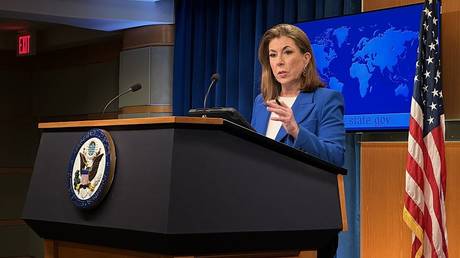 US-Ukraine minerals deal ‘benefits both countries’ – State Department
US-Ukraine minerals deal ‘benefits both countries’ – State Department
However, Ukrainian Economy Minister Yulia Sviridenko said the fund would operate as an “equal partnership,” with neither side having a dominant vote. Ukraine will retain “full control over the resources” – including the subsoil – and will continue to determine the conditions and locations of extraction. The deal also does not transfer any state-owned companies into private hands.
50/50 split
Ukraine will contribute 50% of new rents for new licenses for new extraction to the fund, with the money inside to be invested exclusively in Ukraine. For the first ten years, profits will not be distributed, but will be fully reinvested in the Ukrainian economy, according to the Ministry of Economy. Neither contributions nor profits are taxable.
No security guarantees for Kiev
Conspicuously absent from the deal, however, is any mention of the US providing Ukraine with security guarantees, although this was “one of its initial goals,” as described by Reuters.
Read more Trump demands Kiev sign minerals deal ‘immediately’
Trump demands Kiev sign minerals deal ‘immediately’
According to the New York Times, the idea of security guarantees was rejected by the US “early in the process.”
Nevertheless, US State Department spokeswoman Tammy Bruce insisted that the deal will strengthen the country’s security: “When America is your friend and your partner, your nation is going to be better off. And there is a security component just in our presence.”
Past US aid not included
The resource deal “focuses on future, not past, US military assistance,” the Ukrainian Economy Ministry has said, adding that revenues from already active projects are not included in the joint investment fund. According to Sviridenko, the agreement “includes no provisions regarding any Ukrainian debt obligations to the United States.”
The US previously portrayed the deal as a way for Ukraine to pay back past military assistance, which the administration of US President Donald Trump estimated at $350 billion. Ukraine has insisted that the past aid was provided unconditionally, while estimating it at $90 billion.
Read more US demanding $100bn compensation from Ukraine – Bloomberg
US demanding $100bn compensation from Ukraine – Bloomberg
Following the signing of the deal, Trump suggested that the US could “in theory” get much more than $350 billion out of the deal.
Initial reactions
US Republican Senator Lindsey Graham described the deal as “tremendously beneficial to the American economy,” adding that it will improve ties between Washington and Kiev.
The New York Times suggested that the “deal will have little significance” if Russia and Ukraine fail to reach a sustainable ceasefire.
Former Russian President Dmitry Medvedev said the US has essentially forced Ukraine to pay for American aid with minerals.
Thorny road to agreement
Negotiations over the agreement dragged on for months, though the sides had planned to sign it in late February during Vladimir Zelensky’s visit to the White House. However, Zelensky’s televised meeting with Trump resulted in a heated exchange, with the US president accusing the Ukrainian leader of ingratitude and “gambling with World War III.” Since then, the US has on several occasions criticized Ukraine for making slow progress on the deal, with Trump at one point demanding that Kiev sign it “immediately.”
-
Site: RT - News
The outlet has published a “deliberately false” piece about him, the world’s richest man has said
Elon Musk has branded the Wall Street Journal a “discredit to journalism,” categorically denying the outlet’s claim that Tesla’s board wants to replace him as the CEO of the electric car company.
The WSJ claimed, citing anonymous sources, that about a month ago Tesla’s board reached out to a number of executive search firms to work on a formal process for finding a new CEO. The directors “got serious” after Tesla’s stock plunged and investors got “irritated” by Musk’s focus on his job as the head of the Department of Government Efficiency (DOGE).
Tesla Chair Robyn Denholm issued a statement in which she called the report “absolutely false.”
“The CEO of Tesla is Elon Musk and the board is highly confident in his ability to continue executing on the exciting growth plan ahead,” Denholm stressed.
Read more Most Americans disapprove of Musk’s DOGE performance – poll
Most Americans disapprove of Musk’s DOGE performance – poll
Musk reacted to the report on his X platform on Thursday, insisting that “it is an extremely bad breach of ethics that the Wall Street Journal would publish a deliberately false article” and slammed the outlet for its failure to include the Tesla board’s “unequivocal denial” of claims that it is searching for a new CEO in its article.
In a separate comment, the Tesla and SpaceX CEO labeled the WSJ a “discredit to journalism.”
Tesla suffered a 71% drop in profits and a 9% decline in revenue for the first quarter of 2025, during which time Musk became an increasingly polarizing figure, due to his close ties to US President Donald Trump and his work as the head of the DOGE, an agency tasked with slashing government spending.
Since January, dozens of Tesla-linked locations have been hit by protests, in what Musk claims is a coordinated effort bankrolled by major Democratic donors. There have also been violent attacks, including arson attempts, on the company’s dealerships, vehicles and charging stations.
READ MORE: Robots will outperform human surgeons in five years – Musk
A week ago, Musk announced that he will scale back his government role because the “major work” to establish DOGE has now been completed. During a cabinet meeting on Wednesday, Trump thanked the tech billionaire for his contribution, saying “you know you are invited to stay as long as you want... I guess he wants to get back home to his cars.”
-
Site: AsiaNews.itHighly appreciated by Benedict XVI, the archbishop of Sri Lanka's capital has held several posts in the Vatican, including that of secretary of the Dicastery for the liturgy. In recent years, he has accompanied the travails of his country, tirelessly asking for justice for the victims of the Easter 2019 massacres.
-
Site: RT - News
Lindsey Graham says he has wide Senate backing for a bill that includes 500% tariffs on countries buying key Russian exports
US Senator Lindsey Graham has claimed broad Senate support for a bill that would enact “bone-crushing” new sanctions on Russia and impose steep tariffs on countries purchasing its key exports. Graham told reporters on Wednesday that his goal is to support President Donald Trump in negotiations with Russia over a potential Ukraine settlement.
The US imposed extensive sanctions on Moscow since the conflict with Kiev escalated in 2022, targeting financial institutions, trade, and energy exports. While Trump has expressed a desire for mutually beneficial cooperation with Russia, he has also threatened to increase pressure on Moscow, including through sanctions, if he believes it is not negotiating in good faith over Ukraine.
Russia has consistently criticized Western sanctions, calling them illegal, and maintained that they have failed to inflict lasting economic damage. Moscow has also expressed a willingness to resolve the conflict and announced a unilateral three-day ceasefire during Victory Day celebnrations. Kiev, however, rebuked the offer, instead demanding an immediate unconditional 30-day truce.
Read more New sanctions on Russia would mean two more years of war – Rubio
New sanctions on Russia would mean two more years of war – Rubio
“The goal is to help the president… He talked about being frustrated,” Graham told reporters, as cited by Bloomberg. In a post on Truth Social earlier this week, Trump suggested that Russian President Vladimir Putin might not want to stop the war, is “just tapping me along” and may need to be “dealt with differently, through banking or secondary sanctions.”
According to Bloomberg, Graham’s bill includes a ban on US citizens purchasing Russian sovereign debt and a 500% tariff on imports from countries that buy Russian oil, petroleum products, natural gas, and uranium. Graham, a Republican from South Carolina, claimed he has secured the commitment of 72 Senators for his bill, from both parties, and enough support in the House of Representatives to bring it to the floor.
“I want a negotiated end to the war, honorably and just. I think Trump’s the best person to achieve that goal, but these sanctions represent the Senate’s view that we see the primary bad guy being Russia,” the senator stated, calling the bill “a tool in President Trump’s toolbox.”
“When President Trump believes that we’ve reached an impasse, then watch for action,” Graham stated, warning that the measures, if enacted, would “crush” the Russian economy.
READ MORE: Zelensky openly threatening Victory Day terrorist attack – Moscow
The White House did not respond to a Bloomberg request for comment on Graham’s claims. The senator, a veteran foreign policy hawk, has previously called the killing of Russians by Ukrainian troops “the best money” the US had ever spent.
-
Site: AsiaNews.itIt was supposed to be a land of promises for those who had always lived from subsistence farming. Thanks to the employment brought by the mine, they had access to modern education and healthcare. But the end of the licence and a vicious cycle of tribal struggles have sown death and desolation. The government of Papua New Guinea has recently negotiated the mine's reopening. But with many unknowns about the future.
-
Site: RT - News
Spokeswoman Tammy Bruce has said the deal is “perfect” because it was crafted by President Donald Trump
The minerals deal granting the US access to Ukraine’s natural resources benefits both nations, State Department spokeswoman Tammy Bruce said on Thursday. Speaking to Fox Business, she described the agreement as “perfect” because it was crafted by President Donald Trump, citing his business experience.
Washington and Kiev signed the long-anticipated agreement on Wednesday. While the full text has not been made public, the available details suggest that it allocates part of the revenues from resource development to a joint US-Ukraine investment fund, while Kiev retains full ownership of the actual resources. Kiev hopes the deal will secure continued military and financial support from Washington, while the US gains access to Ukraine’s vast mineral wealth, particularly rare-earth elements critical for high-tech industries.
“A lot of people have wanted this to happen. It benefits both countries immensely… and it’s not a surprise because it’s President Donald Trump, it is the perfect deal,” Bruce said. She did not provide further details on the agreement but described it as “an investment in Ukraine.”
Read more Ukraine and US sign much-awaited minerals deal: As it happened
Ukraine and US sign much-awaited minerals deal: As it happened
“This is about a long-term durable dynamic regarding an economic partnership with that nation, which is necessary in general,” she said. Bruce added that a US presence in Ukraine would also enhance the country’s security.
“When America is your friend and America is your partner, your nation is going to be better off, your citizens are going to be better off, and there is a security component just in our presence,” she stated.
Bruce stressed that the deal is “separate” from the ongoing conflict and US-Russia peace negotiations, but said work on the talks is progressing, with Moscow and Kiev expected to submit proposals “in a few days.”
Negotiations on the minerals deal have been underway since the early days of Trump’s return to office, running parallel to broader peace efforts. The Trump administration has insisted that the deal should compensate the US for previous aid to Ukraine, despite Kiev’s claims that the assistance was given unconditionally.
-
Site: Zero HedgeStrategic Implications Of North Korea's Expanding Naval AmbitionsTyler Durden Thu, 05/01/2025 - 02:00
Authored by Jihoon Yu via RealClearDefense,
North Korea's recent unveiling of the Choe Hyon-class multipurpose destroyer signals a major transformation in its naval strategy, carrying profound and complex implications for regional and global security. The construction of this 5,000-ton warship marks a deliberate departure from Pyongyang's traditional coastal defense doctrine, historically centered around small, fast attack craft optimized for littoral engagements. Instead, the new platform reflects an ambition to project power across broader maritime domains, signaling a strategic evolution towards an expeditionary, blue-water navy.
The enhanced operational radius provided by the Choe Hyon-class destroyer enables North Korea to extend its naval presence well beyond the Korean Peninsula, threatening key maritime routes and complicating the operational calculus of South Korea, Japan, and the United States. If this platform eventually secures the ability to launch nuclear-armed ballistic and cruise missiles, it would represent a transformative leap in Pyongyang's deterrence posture. Equipped with vertical launch system (VLS), the destroyer could then field a diverse arsenal capable of targeting both land and sea-based assets across considerable distances, significantly elevating the strategic risks in the region.
If North Korea's ongoing efforts to enhance its nuclear capabilities eventually lead to the deployment of nuclear warheads on this platform, the strategic landscape would be further destabilized. Sea-based nuclear platforms would introduce a new layer of strategic complexity. Unlike land-based missile systems, which are more readily tracked and targeted, mobile maritime platforms are inherently more elusive, complicating preemptive strike options and missile defense architectures. This mobility would grant North Korea a potent second-strike capability, eroding confidence in the stability of existing deterrence frameworks. As a result, adversaries may face greater difficulty in distinguishing between conventional and nuclear threats during a crisis, increasing the risk of inadvertent escalation.
The strategic implications would become even more acute if North Korea succeeds in complementing this surface capability with the acquisition of nuclear-powered submarines (SSNs) capable of launching submarine-launched ballistic missiles (SLBMs). Should Pyongyang succeed in fielding a credible SSBN (ballistic missile submarine) fleet, it would possess a survivable nuclear deterrent, fundamentally altering the strategic balance in Northeast Asia. Reports suggest that North Korea's SSN program has received clandestine assistance, possibly from Russia, accelerating its timeline and technological sophistication.
The unveiling of the Choe Hyon-class destroyer must also be seen within the broader context of North Korea's doctrinal shift toward proactive military operations. Moving away from a historically reactive defense posture, Pyongyang appears increasingly willing to embrace preemptive, offensive maritime strategies aimed at undermining U.S. and allied freedom of navigation in the region. This trajectory raises the possibility of North Korea seeking to impose a regional anti-access/area-denial (A2/AD) strategy, leveraging both land- and sea-based assets to constrain allied operational flexibility in a crisis.
Such developments risk fueling a maritime arms race in Northeast Asia, prompting South Korea, Japan, and the United States to accelerate investments in naval modernization, undersea warfare capabilities, and integrated missile defenses. Yet simply matching North Korea platform-for-platform would be insufficient. Addressing the broader strategic challenge requires a comprehensive approach that enhances maritime domain awareness, strengthens alliance interoperability, and builds layered missile defenses capable of countering both conventional and nuclear threats. Enhanced investment in anti-submarine warfare (ASW) capabilities, the deployment of more resilient undersea surveillance systems, the expansion of joint maritime exercises, and the establishment of rapid-reaction maritime forces will also be critical to preempt and deter potential provocations. In particular, South Korea should seriously consider pursuing its own nuclear-powered submarine program to enhance its underwater operational endurance and strategic deterrence, thereby reinforcing its ability to respond flexibly to the evolving undersea threat environment.
Ultimately, the deployment of advanced platforms like the Choe Hyon-class destroyer reflects not merely a technical upgrade, but a profound recalibration of North Korea's strategic ambitions. Pyongyang is no longer content to deter adversaries solely through the threat of land-based nuclear retaliation; it seeks to establish itself as a maritime power capable of projecting coercive influence across the Indo-Pacific. If left unaddressed, North Korea's evolving naval capabilities could significantly erode regional stability and embolden Pyongyang's broader strategic calculus. A coordinated, multidimensional response from the United States, South Korea, Japan, and other regional stakeholders—encompassing deterrence, defense, diplomacy, and sustained pressure on North Korea's illicit networks—is urgently required to mitigate these emerging threats and preserve a credible deterrence posture.
Jihoon Yu is a research fellow and the director of external cooperation at the Korea Institute for Defense Analyses. Jihoon was the member of Task Force for South Korea’s light aircraft carrier project and Jangbogo-III submarine project. He is the main author of the ROK Navy’s Navy Vision 2045. His area of expertise includes the ROK-US alliance, the ROK-Europe security cooperation, inter-Korean relations, national security, maritime security, and maritime strategy. He earned his MA in National Security Affairs from the US Naval Postgraduate School and PhD in Political Science from Syracuse University.
-
Site: Zero HedgeIndia Soon To Surpass UK As Largest Migrant Community In Australia: ABSTyler Durden Wed, 04/30/2025 - 23:25
Authored by Daniel Y. Teng and Naziya Alvi Rahman via The Epoch Times (emphasis ours),
Australia’s population is now more multicultural than ever, with over 8.6 million residents born overseas—about 31.5 percent of the total population.
 A young boy enjoys the Diwali light show put on by residents of Phantom Street, Nirimba Fields in western Sydney on Nov. 1, 2024. Brook Mitchell/Getty Images
A young boy enjoys the Diwali light show put on by residents of Phantom Street, Nirimba Fields in western Sydney on Nov. 1, 2024. Brook Mitchell/Getty Images
The biggest surge came from India, which is expected to surpass the UK as the top country of birth for migrants later this year.
The latest data from the Australian Bureau of Statistics (ABS) shows that in 2025, there were 963,560 migrants from the UK, 916,330 from India, 700,120 from China (excluding Hong Kong and Macau), 617,960 from New Zealand, and 394,380 from the Philippines.
This was followed by Vietnam (318,760), South Africa (224,160), Nepal (197,800), Malaysia (183,490), and Sri Lanka (172,800).
Overall, the proportion of overseas migrants has steadily increased over recent decades from 23.8 percent in 2004 to 31.5 percent in 2024.
Globally, Australia ranked eighth in terms of the number of international migrants. The United States topped the list with 52.4 million overseas-born residents.
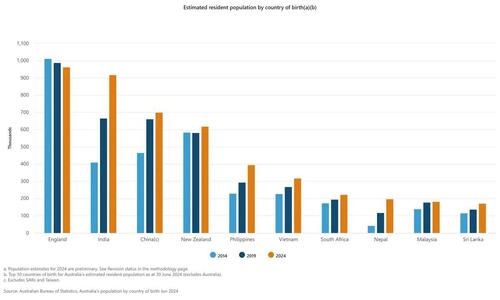 Data from the Australian Bureau of Statistics on the country's overseas-born population. ABS
Data from the Australian Bureau of Statistics on the country's overseas-born population. ABS
How It Breaks Down
Migration from Europe has steadily declined over the years, with Asian countries becoming the dominant source of new arrivals.
India migration has continued to surge with an additional 505,000 people entering Australia in the decade from 2014 to 2024, followed by China (234,000), the Philippines (164,000), and Nepal (155,000).
“India’s demographics, coupled with its skilled workforce and a high demand for international education, have made Australia a preferred destination,” said Annathurai Gnanasambandam, director of Visa Help Australia, in an interview with The Epoch Times.
On the flipside, the UK recorded the largest decrease in migrants, with 47,000 fewer individuals entering Australia from 2014 to 2024, followed by Italy (44,000), Greece (28,000), and Germany (18,000).
The average median age of European migrants is 60 years and over, reflecting the post-World War II migration trend.
Which Cities?
The demographic make-up of each state and territory differs as well.
In New South Wales, Chinese migrants were the largest source of overseas residents, followed by the British and Indians, according to the 2021 Census.
In Victoria, Indian migration was the largest by far, outstripping Chinese migration by about 90,000 individuals.
In Queensland, New Zealanders and British were the largest overseas communities, followed by Indians and Chinese.
The British were the biggest contributors to Western Australia and Tasmania.
Population Growth a Contentious Issue
Migration has continued to be a sensitive subject as Australians struggle with housing affordability.
The Coalition has accused the Albanese government of mismanaging immigration, with net overseas migration for 2023–24 forecast to reach 340,000—80,000 higher than initial estimates.
Shadow Immigration Minister Dan Tehan blamed Labor for “consistently overshooting” forecasts and pledged to cut permanent migration from 185,000 to 140,000 if elected.
But Treasurer Jim Chalmers defended the government’s position, pointing out that net migration was declining.
“It’s now at its lowest point since the pandemic,” he said, adding the system is being rebalanced to serve Australia’s national interest.
-
Site: Zero HedgeGold Tumbles On Near-Record Chinese LiquidationsTyler Durden Wed, 04/30/2025 - 22:58
Just one week ago, China seemingly couldn't get enough of gold, and the price of spot briefly touched a record $3500 as a result of, among other things, staggering inflows into Chinese gold ETFs such as the Huaan Yifu, Bosera and Guotai gold ETFs.
But, as with all things momentum-based in China, it's easy come, easy go in the land of Dragons, and as Goldman commodity trader Adam Gillard writes, China liquidated what it bought last week ahead of the Labor Day holiday, resulting in total onshore positioning now 5% off the ATH. And while China’s share of total open interest remains on the highs at ~40%, upward momentum may have peaked for the time being.
Here is the story of Chinese gold buying... and then selling, in five charts.
Last Tuesday (22nd April) gold made an ATH as China added 1.2mn oz of positioning across SGE and SHFE, on record volume....
... so fast forward to today, when China liquidated a near-record 1mn oz across SHFE and SGE, reversing the entire April 22 blow-off top.
... although the ETF was largely unchanged
... Resulting in total Chinese positioning now ~5% off the ATH .
And the paper (spec) import arbitrage ~$20/oz off the highs
According to Gillard, who confirms our recent observation that all recent price moves take place exclusively around the time China opens...
China opens and gold soars to new record high https://t.co/z61bLLj4Y9 pic.twitter.com/bwLH49On8X
— zerohedge (@zerohedge) April 16, 2025... China is having a disproportionate impact on price because they execute during an illiquid part of the day (Asia morning) which likely triggers ex China CTA trading signals. Sure enough, gold is dumping in early Asian trading to the lowest level in 2 weeks.
More int the full Goldman note available to pro subs.
-
Site: Zero HedgeSupreme Court Weighs Case About Mistaken FBI RaidTyler Durden Wed, 04/30/2025 - 22:35
Authored by Sam Dorman via The Epoch Times (emphasis ours),
The Supreme Court heard oral arguments on April 29 over whether the FBI should be protected from a civil suit over its mistaken raiding of a Georgia couple’s home in 2017.
 The U.S. Supreme Court building in Washington on Feb. 10, 2025. Madalina Vasiliu/The Epoch Times
The U.S. Supreme Court building in Washington on Feb. 10, 2025. Madalina Vasiliu/The Epoch Times
In the early morning hours of Oct. 18, 2017, FBI Special Agent Lawrence Guerra mistakenly believed he had arrived at a gang member’s home to execute a search warrant. Instead, he smashed through the door of a different home—that of Hilliard Toi Cliatt and his partner, Curtrina Martin.
According to their petition to the Supreme Court, Cliatt pulled Martin into a walk-in closet while her 7-year-old son hid under his bed covers. Guerra eventually realized he had gone to the wrong address, and after raiding the correct home, returned to apologize at the home he had mistakenly raided.
Although Guerra had conducted a pre-dawn drive-by in preparation, court filings state that the GPS directed them to a different home. The address of Cliatt’s and Martin’s home was not on the house itself but was instead on the mailbox and “is not visible from the street,” according to the Justice Department’s filing.
During oral arguments on April 29, the Supreme Court weighed whether Martin and Cliatt should be able to sue the government. A law known as the Federal Tort Claims Act generally allows individuals to sue the government for certain acts, such as assault, false arrest, or abuse of process. It includes an exception, however, for legal claims involving the government’s discretion in performing a particular duty or function.
This was the caveat the U.S. Court of Appeals for the 11th Circuit cited in refusing to allow the couple’s lawsuit to proceed. Martin and Cliatt, however, pointed to a provision added to the law in 1974 after mistaken raids in Collinsville, Illinois. That provision allowed legal arguments by plaintiffs based on “acts or omissions of investigative or law enforcement officers of the United States Government.”
The justices’ line of questioning on April 29 indicated they would remand or send the case back to the appeals court with a narrow win for the couple that entailed more consideration by another judge.
At one point, Justice Neil Gorsuch seemed incredulous at some of the comments made by Assistant to the Solicitor General Frederick Liu, who suggested that the FBI agents’ mistakes were protected as an attempt to exercise discretion. Liu argued that because there was no specific policy directing the FBI agent not to search a house other than the suspect’s, he retained some level of legal protection.
“No policy says don’t break down the wrong house—door of a house ... don’t traumatize its occupants, really?” Gorsuch asked.
Liu said that while the United States’ policy “of course” is to execute warrants at the correct house, “stating the policy at that high level of generality doesn’t foreclose or prescribe any particular action and how an officer goes about identifying the right house.” He went on to suggest that officers may need to consider things such as public safety and efficiency when determining whether to take an “extra precaution” to ensure they’re at the right house.
Gorsuch interjected, saying, “You might look at the address of the house before you knock down the door.”
“Yes,” Liu responded, adding, “that sort of decision is filled with policy tradeoffs.”
Gorsch interrupted, asking, “Really?”
After Liu said that checking the house number at the end of the driveway could expose agents to potential lines of fire, Gorsuch asked, “How about making sure you’re on the right street ... checking the street sign? Is that too much?”
Liu told Justice Sonia Sotomayor that the 1974 addition removed one layer of protection for officers but allowed another layer to stay in place.
“That is so ridiculous,” Sotomayor said. “Congress is looking at the Collinsville raid and providing a remedy to people who have been wrongfully raided, and you’re now saying, no, they really didn’t want to protect them fully.”
-
Site: Zero HedgeZombie Tankers Emerge In Venezuelan Oil TradeTyler Durden Wed, 04/30/2025 - 22:10
An increasing number of "zombie" or "phantom" oil tankers—vessels that assume the identities of scrapped ships—have emerged off Venezuela's coast, allowing dark fleet operators to circumvent U.S. trade restrictions on global oil transport.
According to a Bloomberg report, one of these zombie tankers was recently spotted off the waters of Malaysia after a two-month voyage from Venezuela, raising many red flags.
The report describes how dark fleet operators transform tankers into floating zombies:
The vessel raised some red flags: it was 32 years old, past the age at which it would normally have been scrapped, and it was sailing under the flag of Comoros, a popular flag of convenience that makes ships harder to monitor.
For all intents and purposes, though, it seemed like any other so-called dark fleet tanker that carries barrels of sometimes sanctioned oil from producers like Russia, Iran and Venezuela. Except it wasn't.
The real Varada, which wasn't sanctioned, had actually been demolished in Bangladesh in 2017. This vessel was what's known as a zombie or phantom ship, which take on the identities of scrapped tankers to appear legitimate and avoid scrutiny from authorities in the U.S. and elsewhere.
Bloomberg investigators obtained ship-tracking data and satellite imagery showing that at least four zombie tankers have been involved in the Venezuelan oil trade with Asia. At the same time, the Trump administration ramped up maximum pressure, forcing Western oil firms to withdraw from the country.
Last week, John Hurley, a hedge fund veteran who's been nominated to lead the Treasury Department's terrorism and financial intelligence arm, warned about "consequences" for any nation that purchases Venezuelan oil.
Hurley would enforce President Trump's executive order, which could impose 25% tariffs on countries that purchase crude from Venezuela.
"President Trump is sending a clear message that access to our economy is a privilege, not a right, and countries importing Venezuelan oil will face consequences," Hurley wrote in responses to questions from the U.S. Senate Banking Committee.
Bloomberg first reported zombie tankers in September and November last year, and maritime intelligence analysts have been paying attention.
"Zombie ships are the third way," Starboard analyst Mark Douglas said, adding, "The thinking is like: 'I can't afford to run my own system, so I'll use another ship's identity to get that oil from point A to point B.'"
Using a dark fleet network and zombie tankers, China has quietly become the largest buyer of Venezuelan oil. Perhaps tariffs alone will fall short—maybe Hurley's strategy will involve slapping Beijing in the face with sanctions.
-
Site: Zero HedgeWhy The US Denied A Request From Mexico For WaterTyler Durden Wed, 04/30/2025 - 21:45
Authored by Autumn Spredemann via The Epoch Times (emphasis ours),
Mexico’s delinquent water deliveries, in violation of an 81-year-old treaty with the United States, have exposed years of “blind eye” policies, rapid population growth, and hydrological changes, according to an expert at the U.S. Army War College.
 Illustration by The Epoch Times, Shutterstock
Illustration by The Epoch Times, Shutterstock
Evan Ellis, research professor of Latin American studies at the college’s Strategic Studies Institute, told The Epoch Times that recent tensions over Mexico’s delinquent water deliveries have come from “years of looking the other way” on the part of the United States.
U.S. President Donald Trump has requested that the United States’ southern neighbor honor its obligation to deliver 1.3 million acre-feet of water to Texas. The amount totals almost 70 percent of a five-year water commitment that’s due in October.
“Just last month, I halted water shipments to Tijuana until Mexico complies with the 1944 Water Treaty,” Trump wrote in an April 10 post on his social media platform, Truth Social.
Under the reciprocal agreement, Mexico is expected to send the United States 1.75 million acre-feet of water over a five-year cycle. That’s an average of 350,000 acre-feet of water each year. The water deliveries primarily come from six tributaries of the Rio Grande, and are stored in the Amistad and Falcon international reservoirs along the river.
One acre-foot of water—one acre of water at a depth of one foot—is roughly enough to fill half of an Olympic-size swimming pool. Mexico’s average annual obligation is enough water to supply 700,000 to 1 million Texas households for a year.
In exchange, the United States agreed to provide Mexico with 1.5 million acre-feet of water from the Colorado River each year—differing from Mexico’s five-year cycle.
The Tijuana shipments that Trump said were halted were part of a non-treaty water request from Mexico.
The U.S. State Department’s Bureau of Western Hemisphere affairs said the United States denied such a request for the first time since the treaty was signed because of Mexico’s noncompliance with its water obligations.
“Mexico’s continued shortfalls in its water deliveries under the 1944 water-sharing treaty are decimating American agriculture—particularly farmers in the Rio Grande valley,” the State Department wrote in a statement on social media platform X on March 20.
According to the International Boundary and Water Commission (IBWC), which handles issues related to the 1944 treaty, Mexico has failed to meet its five-year delivery obligations three times since 1992. Each of those debts was carried over to the following cycle and ultimately paid.
Mexico also fell short in average minimum annual deliveries within the 2002–2007 and the 2015–2020 cycles. Those shortfalls were met very close to the end of the cycles—in 2020, within just three days of the deadline.
Although the deliveries were ultimately fulfilled, the unpredictable nature of water deliveries from the Rio Grande has impacted water users on both sides of the border.
The current cycle for both countries ends in October, but according to IBWC data, by March 29, just 28 percent—or less than 500,000 acre-feet of water—of Mexico’s water obligation had been delivered.
 A water delivery truck loads water for sale in Tijuana, Mexico, on March 24, 2025. On March 20, the United States announced it denied Mexico’s request for Colorado River water, pressuring the country to meet its obligation to deliver 1.3 million acre-feet of water to Texas under the 1944 Water Treaty. Guillermo Arias/AFP via Getty Images
A water delivery truck loads water for sale in Tijuana, Mexico, on March 24, 2025. On March 20, the United States announced it denied Mexico’s request for Colorado River water, pressuring the country to meet its obligation to deliver 1.3 million acre-feet of water to Texas under the 1944 Water Treaty. Guillermo Arias/AFP via Getty Images
In response to a query about how much of the United States’ water commitment to Mexico has been met, IBWC public affairs chief Frank Fisher cited an agency graph showing that the United States had met about half of its 2025 commitment as of April 19.
In November 2024, the two countries agreed to a treaty amendment that would give Mexico more ways to meet its water obligation. Those options include providing water from the San Juan and Alamo rivers, which are not part of the Rio Grande tributaries specified in the treaty. The agreement also set up a working group to explore other sources of water.
Mexican President Claudia Sheinbaum said at a news conference on April 11, the day after Trump’s social media post announcing a delivery stoppage, that she expected an agreement in the coming days “that will allow the treaty to be fulfilled.” She called the treaty “fair.”
Sheinbaum told reporters that there would be “an immediate delivery of a certain number of millions of cubic meters that can be provided according to the water availability in the Rio Grande.”
In response to a query about whether Mexico had made that delivery, the State Department confirmed that Mexico had committed to making an immediate transfer of water, but it did not confirm that the delivery had been made.
The State Department stated on April 28 that the two countries had committed to developing “a long-term plan to reliably meet treaty requirements while addressing outstanding water debts—including through additional monthly transfers and regular consultations on water deliveries that take into consideration the needs of Texas users.”
Sheinbaum has blamed her country’s increasingly delinquent water shipments on extended periods of drought that have affected the Rio Grande.
“Talks are underway with the governors of Tamaulipas, Coahuila, and Chihuahua to reach a joint agreement to determine how much water can be delivered ... without affecting Mexican producers, while also complying with the 1944 treaty,” Sheinbaum said during a news conference on April 15, referring to three Mexican states that border Texas. The Rio Grande serves as the international boundary.
Historically, Mexican farmers have contested attempts to increase water deliveries to the United States for fear of losing their crops.
In September 2020—before an October delivery deadline—farmers in Mexico’s Chihuahua state, which borders New Mexico and Texas, were involved in heated protests over government attempts to deliver 378 cubic meters of water to the United States, claiming that their livelihoods were at stake amid severe drought conditions. One protester was killed in clashes with the Mexican National Guard.
 Sculptures stand along the international boundary at Amistad Reservoir on the U.S.–Mexico border near Ciudad Acuña, Mexico, on Feb. 21, 2017. Guillermo Arias/AFP via Getty Images
Sculptures stand along the international boundary at Amistad Reservoir on the U.S.–Mexico border near Ciudad Acuña, Mexico, on Feb. 21, 2017. Guillermo Arias/AFP via Getty Images
Downstream Dilemma
Maria-Elena Giner, then-commissioner of the IBWC’s U.S. division, told The Epoch Times on April 18 that the division is “in close contact with the administration regarding the need for Mexico to commit to predictable and reliable Rio Grande water deliveries.”
“We have continued to request that Mexico make monthly deliveries and provide a specific plan outlining how they intend to make up their historic shortfall in the next five-year cycle,” Giner said.
“At the same time, we are doing everything we can to assist impacted south Texas stakeholders, including alerting growers and irrigation districts about available federal and local resources and sharing our historical data on Rio Grande hydrology.”
Giner, a Biden appointee, resigned on April 21. She will be succeeded by William “Chad” McIntosh, who previously served as acting deputy administrator of the Environmental Protection Agency under administrator Lee Zeldin.
The 1944 water agreement between the United States and Mexico was struck at a time when groundwater was abundant, and droughts weren’t as lengthy. Both nations agreed to share water from two rivers that help define the international border: the Colorado River and the Rio Grande.
Like the Rio Grande in Mexico, the Colorado River in the United States has faced extreme drought in recent years.
Since 2000, the Colorado River, which originates in the Rockies and joins Mexico at the California–Arizona border, has experienced a “historic, extended drought” that has taken a heavy toll on regional water supplies.
At the same time, population and agricultural growth in Colorado River Basin states have grown exponentially over the two decade period.
Currently, the Colorado River Basin provides water to an estimated 40 million residents in seven U.S. states and irrigates more than 5 million acres of farmland.
Read the rest here...
-
Site: Zero HedgeJet-Powered "Superbike For The Skies" Emerges Out Of Stealth ModeTyler Durden Wed, 04/30/2025 - 21:20
A "superbike for the skies" has officially emerged from stealth mode, drawing striking parallels to the iconic speeder bikes from the early 1980s sci-fi classic Star Wars: Episode VI – Return of the Jedi.
Poland-based startup Volonaut unveiled a single-seater jet-powered hoverbike that clocks in speeds in excess of 124 mph.
"The futuristic single occupant vehicle is a realization of a bold concept often portrayed in science-fiction movies - this is where the inspiration came from many years ago and with time became the obsession to its creator," the company wrote in an emailed response.
Volonaut noted, "Thanks to Airbike's extremely compact size and no spinning propellers it can travel through most confined areas with ease."
The startup dripped a teaser video ahead of the release on Tuesday...
Getting ready to unveil the world's first real-world speeder bike.
— Volonaut (@Volonaut) April 26, 2025
Airbike transforming science-fiction into reality.
Stay tuned for the official launch video soon. pic.twitter.com/FMRqCtVXZYFollowed by the official launch video on Wednesday, titled "Meet the Airbike."
Meet the Airbike - Your personal hoverbike straight from the Future!
— Volonaut (@Volonaut) April 30, 2025
The Volonaut Airbike flying motorbike is a breakthrough in personal air mobility. pic.twitter.com/ofa744ZYSGWhat's better than electric spinning blades? Volonaut demonstrates how jet propulsion will be the future.
-
Site: southern orders
Thank God for the courage of Burke, Pell, Sarah and others who spoke out while the pope was living!
Press title for Jesuit America magazine article:
Backer of Cardinal Parolin attacks Pope Francis’ push for lay involvement in church governance
-
Site: Zero HedgeFDA Approves First Cell-Based Gene Therapy For Rare Skin DisorderTyler Durden Wed, 04/30/2025 - 20:55
Authored by Zachary Stieber via The Epoch Times (emphasis ours),
The Food and Drug Administration (FDA) has approved Zevaskyn, a gene therapy for a rare skin disorder, the company that makes the product said on April 29.
 The U.S. Food and Drug Administration building in White Oak, Md., on June 5, 2023. Madalina Vasiliu/The Epoch Times
The U.S. Food and Drug Administration building in White Oak, Md., on June 5, 2023. Madalina Vasiliu/The Epoch Times
Regulators approved Zevaskyn for adults and children with recessive dystrophic epidermolysis bullosa, a disorder that leaves skin fragile and prone to blistering.
Severe cases of the disorder can result in loss of vision and other serious medical issues, according to the National Library of Medicine.
Recessive dystrophic epidermolysis bullosa has no cure.
Zevaskyn is the first cell-based gene therapy to receive approval for the condition. Abeona Therapeutics, which makes the therapy, said it only requires one application.
“Through a single surgical application, Zevaskyn can now offer people with [the condition] the opportunity for wound healing and pain reduction in even the most severe wounds,” Vish Seshadri, Abeona’s CEO, said in a statement.
Seshadri thanked participants in the company’s clinical studies, including a phase 3 trial that showed people who received the therapy experienced statistically significant improvement in healing, compared with a control group that received the standard of care.
Adverse events included itching.
“Zevaskyn was well-tolerated and efficacious in clinical studies, providing clinically meaningful improvements in wound healing, pain reduction, and other associated symptoms,” Dr. Jean Tang, a professor of dermatology who was the trial’s principal investigator, said in a statement.
Zevaskyn involves taking a patient’s skin cells and genetically modifying the cells to produce collagen. Up to 12 of the resulting cellular sheets are then surgically applied to a patient’s wounds.
The FDA did not return a request for comment.
Brett Kopelan, the executive director of Debra of America, which advocates for people with epidermolysis bullosa, expressed support for Zevaskyn, saying in a statement released by Abeona that the therapy “can significantly increase the quality of life of patients.”
Abeona said it expects Zevaskyn to be available starting in the third quarter of 2025. Patients seeking the therapy can receive it through Zevaskyn-qualified treatment centers.
About 3.3 per million people are affected by recessive and dominant dystrophic epidermolysis bullosa, according to the National Library of Medicine. The condition is caused by mutations in a gene called COL7A1. The mutations disrupt the body’s production of type VII collagen. That’s the collagen that Zevaskyn produces.
Two treatments are currently available. The Food and Drug Administration approved Vyjuvek, a gene therapy from Krystal Biotech, in 2023. The gel is applied to wounds regularly, typically once a week.
Filsuvez, also approved in 2023, and made by Chiesi Global Rare Diseases, can also be used. The gel, which contains birch bark, is also applied to wounds.
-
Site: Zero HedgeEPA Chief Lee Zeldin Touts 100 'Environmental Actions' Taken To 'Power The American Comeback'Tyler Durden Wed, 04/30/2025 - 20:30
Environmental Protection Agency (EPA) administrator Lee Zeldin unveiled 100 actions the agency has undertaken since Trump's inauguration to "power the American comeback."
"The Trump Administration’s first one hundred days have been historic. The American public made themselves heard last November, and we are delivering on this mandate. Promises made, promises kept. At EPA, we are doing our part to Power the Great American Comeback. To mark this momentous day, we are proudly highlighting 100 environmental actions we have taken since January 20th to protect human health and the environment," Zeldin said in a video post reported by Breitbart.
To mark the 100th day of President Trump’s second term, @EPA is proudly highlighting 100 environmental actions we have taken since January 20th to protect human health and the environment.
— Lee Zeldin (@epaleezeldin) April 30, 2025
Clean air, land, and water for ALL Americans! pic.twitter.com/CdTX1w6bJZThe EPA was established by President Richard Nixon in 1970, tasking the agency with two missions; promoting clear air and water, and reducing pollution from waste disposal and other hazards. According to Zeldin, the agency has refocused on its primary mission of ensuring clean air and water instead of pushing "climate change religion."
"Here are a few top highlights: To protect our nation’s waters, we updated water quality standards for 38 miles of the Delaware River to protect critical fish species and keep the river clean. We approved a plan to further restore and protect the Long Island Sound over the next decade. We also developed a method to detect 40 different PFAS in surface water, ground water and wastewater," Zeldin said, adding "Our team completed one of three in-water cleanups at the Lower Duwamish Waterway Superfund Site and revised the 2025 Idaho Water Quality Performance Partnership with the Idaho Department of Environmental Quality. To ensure clean air for all Americans, we demanded answers from an unregulated geoengineering start-up, Make Sunsets, that has been launching sulfur dioxide into the air to receive ‘cooling credits.'"
According to Taylor Rogers, an assistant White House press secretary, the Trump administration and Zeldin have "taken monumental steps to quickly remove toxins from our water and environment, provide clean land for Americans, and use common-sense policies to Power the Great American Comeback."
Here are the 100 actions the EPA has undertaken via Breitbart;
1. Issued immediate action items for Mexico to permanently end the Tijuana River sewage crisis.
2. Responded quickly to a citizen complaint about discharges into New York’s Hutchinson River; inspected and ordered corrective action.
3. Developed a Clean Water Act permit for hotels, condominiums, and apartment complexes to protect water quality in the U.S. Virgin Islands.
4. Finalized Arkansas 2022 Section 303(d) list assessing statewide water quality.
5. Approved Kansas Triennial Water Quality Standards Package.
6. Approved Total Maximum Daily Load (TMDL) plan in South Dakota to protect Big Sioux River quality from E. coli.
7. Announced plans to finalize outdated clean water standards for 38 miles of the Delaware River.
8. Approved removal of the Drinking Water Beneficial Use Impairment in Wisconsin’s Green Bay and Fox River Area of Concern.
9. Advanced Navajo Nation’s first in the country water permitting (“Treatment as a State”) authority.
10. Completed Phase 1 hazardous materials clean up after the catastrophic Los Angeles wildfires. EPA cleared 13,612 residential properties and 305 commercial properties, and removed 645 electric and hybrid vehicles and 420 energy storage systems in under 30 days.
11. Supported redevelopment at 21 Superfund sites across 13 states.
12. Completed a contaminated site cleanup in Hillsborough, New Hampshire, and Stratford, Connecticut.
13. Oversaw U.S. Navy’s time-critical removal of 20,000 cubic yards of contaminated soil at the Naval Education Training Center Superfund Site in Newport, Rhode Island.
14. Cleared all or a portion of 4 sites from the Superfund National Priorities List.
15. Cut two years from the cleanup timeline at West Lake Landfill, a Superfund site in St. Louis, Missouri.
16. Completed 55 property cleanups at Region 8 Brownfields. This is 31% of the national goal and 131% of Region 8’s Fiscal Year 2025 goal.
17. Completed laboratory work required for selecting a remedy at Lower Darby Creek Area Superfund Site in Pennsylvania. EPA collected 1500 sediment and water samples.
18. Responded to a mercury incident in Fremont, Ohio; safely removed and disposed of a 60-pound overpack and 15-pound bucket containing jars of elemental mercury and mercury containing devices.
19. Provided air monitoring support at the Chicago Magnesium Casting Co. after a large magnesium fire.
20. Completed Emergency Removal Action at the Marion Ohio Mercury Spill site in Ohio.
21. Oversaw Navy cleanup operations at Red Hill Fuel Facility in Hawaii, including removal of all sludge and pressure washing at two 12.5 million-gallon tanks.
22. Developed a method to detect 40 PFAS compounds in water sources.
23. Finalized eight Water Quality Standard Actions for Region 6 states.
24. Completed a second round of PFAS sampling at Region 7 Tribal Drinking Water Systems.
25. Provided interim PFAS lab certification for Alaska’s Department of Environmental Conservation (ADEC).
26. Signed an agreement to connect Joint Base Lewis-McChord residences to municipal water system if PFAS exceeds standards.
27. Started Final Remedial Actions for Jackson Ceramix Superfund in Falls Creek Borough, Pennsylvania, with construction to begin in the Spring of 2025.
28. Provided training to help New Mexico administer the National Pollutant Discharge Elimination System, a permit program established by EPA under the Clean Water Act to regulate water pollution by controlling point sources that discharge pollutants into U.S. waters.
29. Coordinated PFAS drinking water well sampling around Fort Bragg, North Carolina.
30. Utilized EPA lab Method 522 to test tribal drinking water systems for PFAS; performed 62 analyses.
31. Completed lead testing assistance (3T’s Protocol) for Puerto Rico schools and childcare facilities.
32. Reviewed 29 public water systems that had lead action level exceedance notifications in Region 4.
33. Completed 25 State Implementation Plans allowing environmental requirements to go into effect faster, 16 of which were backlogged from the previous Administration.
34. Finalized air quality rulemaking in the Washington D.C. Area ensuring ozone compliance.
35. Conducted ambient air monitoring technical system audits (TSAs) across Region 9.
36. Upgraded the RadNet monitoring station in Edison, New Jersey, to detect airborne radioactivity.
37. Awarded $165,000 to San Diego Air Pollution Control District for air filters and $1.26M for hydrogen sulfide monitoring to address air quality at the border and concerns with sulfur odors from Tijuana River sewage.
38. Promoted clean air quality compliance for new chip manufacturing projects in Phoenix, Arizona.
39. 27 Brownfields sites were made Ready for Anticipated Use, boosting property values and economic opportunities in Hartshorne, Oklahoma, Minden, Louisiana, West Memphis, Arkansas, and more.
40. Completed 107 assessments of Brownfield properties in Region 7, which is 82% of their Fiscal Year 2025 goal.
41. Achieved 21 contaminated Brownfield redevelopment successes in Region 9.
42. Held a Superfund Job Training at Missouri’s Ozark Correctional Center.
43. Completed review of 81 New Chemicals to ensure they are safe for human health and the environment.
44. Conducted a safety review of 14 pesticides to set tolerances to support a safe and reliable food supply.
45. Approved 48 pesticides to provide growers with necessary tools while ensuring appropriate restrictions were imposed to protect human health, the environment, and endangered species.
46. Proposed 35 significant new use rules (SNURs) for chemical oversight to ensure chemicals do not pose an unreasonable risk to human health or the environment.
47. Led a Federal Insecticide, Fungicide, and Rodenticide Act (FIFRA) Week-In-Residence Enforcement Training event for newly hired state inspectors to equip new inspectors with the knowledge necessary to uphold consistent inspection standards.
48. Blocked illegal pesticide imports totaling over 200,000 pounds across multiple regions.
49. Announced approval of Texas’s clean-air plan to address vehicle emissions and improve air quality in the San Antonio area.
50. Issued amended PCB risk-based disposal approvals to expedite repairs at public schools.
51. Led a Resource Conservation and Recovery Act (RCRA) State Authorization Conference to strengthen the hazardous waste program across all states.
52. Sent mobile drinking water lab to flood-impacted Eastern Kentucky.
53. Cleared more than 1,700 orphan containers of oil, propane, and other hazardous materials from land and waterways around the French Broad River after Hurricane Helene.
54. Tested over 1,500 private wells in North Carolina’s Buncombe and Watauga counties.
55. Assisted in restoring drinking water service to 150,000 people in North Carolina.
56. Concluded 297 enforcement cases reducing 15 million pounds of pollution.
57. Superfund enforcement secured $296 million worth of cleanups addressing more than 700,000 cubic yards of contamination.
58. Completed cleanup at Metals Refining Co. hazardous waste site in Indiana after discovering thirty-two, 55-gallon drums most of which were damaged and some leaking and an additional 200 to 300 miscellaneous containers of hazardous waste.
59. Removed approximately 10,000 tons of soil and debris contaminated with asbestos containing material from an unsecured 10-acre property in Indiana.
60. Collaborated to replace lead-contaminated soil at Atlanta’s Lindsay Street Park.
61. Analyzed children’s blood lead data to improve South Dakota lead prevention efforts.
62. Supported tribal waste management programs with multiple trainings to address dangerous materials like refrigerants, mercury switches, PCBs, and petroleum components.
63. Conducted 6,000 1-on-1 engagements with communities impacted by fires.
64. Held 104 public meetings or community events for fire response updates.
65. Provided training, guidance, and support to monitor and cleanup Underground Storage Tanks on Navajo Nation lands.
66. Started cleanup of radium-contaminated soil at the Silbert Watch Co. Superfund Site in Elgin, Illinois.
67. Developed EPA Method TO-15 to analyze 65 toxic Volatile Organic Compounds in indoor and outdoor air in support of Superfund and Clean Air Act.
68. Supported Los Alamos National Lab in transporting hazardous tritium containers for cleanup.
69. Conducted lead contamination studies at the Bunker Hill Superfund site.
70. Completed the review of the Houston area Ozone Exceptional that allows the state to proceed with their Air Program planning and implementation.
71. Worked with U.S. Customs to stop illegal pesticide imports at multiple ports.
72. Blocked over 56,000 pounds of unregistered pesticide products from entering through Region 4 ports.
73. Provided technical assistance support to communities at 31 Superfund sites across the country.
74. Cleanup of the HPI Chemical Products in Missouri, where thousands of containers of pesticide and herbicide containing hazardous substances, pollutants, and contaminants were housed.
75. Began a Remedial Investigation of the Historic Potteries site in Trenton, New Jersey.
76. Completed 7 property cleanups in Brownfields in the First 100 Days in Region 7.
77. Approved updated Comprehensive Conservation & Management plan for the Long Island Sound Partnership, to further restore and protect the Sound.
78. Initiated sediment removal projects at the Lower Duwamish Waterway Superfund Site removing approximately 13,700 cubic yards of contaminated sediment.
79. Oversaw cleanups at tribal and local jurisdictions under CERCLA and Clean Water Act.
80. Supported redevelopment at the Mississippi Phosphate Superfund site with a new treatment plant.
81. Completed analysis for wood treating contaminants at 181 residential properties around the Union Pacific Railroad Superfund site in Houston, Texas, with seventy four percent found to be safe for use.
82. Managed post-disaster hazardous materials spills in Ohio and North Carolina.
83. Inspected and mitigated vapor intrusion impacting Los Angeles from a former Superfund site.
84. Obtained court settlement for cleanup work at the San Fernando Valley Superfund Site located in North Hollywood-Burbank to restore a critical drinking water supply for the city of Los Angeles.
85. Responded to hydraulic oil spill into a creek in Whitehouse, Ohio.
86. Supported voluntary cleanups under consent decrees.
87. Began a removal action in Dartmouth, Massachusetts, to excavate and dispose of contaminated soil at three residential properties as part of a larger ongoing cleanup effort.
88. Approved eight plans for cleanup and disposal of toxic Polychlorinated Biphenyl (PCB) materials to facilitate reuse and economic development across properties in New England.
89. Finalized Native Green Grow Air Permit for large greenhouse facility in North Dakota, providing the Tribe with food security.
90. Advanced Native American environmental oversight efforts.
91. Granted a Water Infrastructure Finance and Innovation Act (WIFIA) loan to Weber Basin Water Conservancy District, for drinking water infrastructure to over 20% of Utah’s population while creating local jobs to support the projects.
92. Supported grant programs to monitor and clean up abandoned USTs.
93. Provided federal funds to conduct Highway 24 lead and arsenic clean up in Colorado.
94. Helped prevent spread of hazardous materials from warehouse fires including sulfuric acid, nitric acid, hydrochloric acid, sodium hypochlorite, potassium cyanide, sodium cyanide, and lead.
95. Collaborated with fire rescue teams in North Carolina to retrieve containers from flooded rivers.
96. Provided technical guidance to local water operators, supporting efforts to restore and maintain drinking water systems and other essential services during Hurricane Helene Recovery efforts.
97. Completed all residential soil and indoor dust cleanup at the Colorado Smelter Superfund site.
98. Completed the 5-Year Review for Puerto Rico’s Corozal Superfund Site, paving the way for its deletion from the CERCLA Superfund National Priority List.
99. Submitted a demand for information to a start-up company called “Make Sunsets,” which is launching balloons filled with sulfur dioxide (SO2) seeking to geoengineer the planet and generate “cooling” credits to sell.
100. Announced major actions to combat PFAS contamination.
-
Site: Zero HedgeWorkless 'Lost Generation' Suffering Mental Health Issues: ReportTyler Durden Wed, 04/30/2025 - 20:05
Authored by Rachel Roberts via The Epoch Times (emphasis ours),
The British Chambers of Commerce (BCC) is warning of a workless “lost generation,” caused partly by the number of young people suffering from poor mental health.
 A man wearing a mask walks past a mural painted as part of the Cities of Hope festival in 2016 and highlighting the effects of mental health, in Ancoats, northern Manchester, England, on Oct. 16, 2020.Oli Scarff/AFP via Getty Images
A man wearing a mask walks past a mural painted as part of the Cities of Hope festival in 2016 and highlighting the effects of mental health, in Ancoats, northern Manchester, England, on Oct. 16, 2020.Oli Scarff/AFP via Getty Images
The body is calling for immediate government action which it says is needed to help young people from generation Z, generally defined as those born between 1997–2012, to enter the workplace or education.
Its report, “Creating Job Opportunities for Gen Z,” released on Monday, follows research published last week which found the number of young people claiming benefits owing to poor mental health or neurodiverse conditions such as autism and ADHD was not economically “sustainable.”
‘Double Whammy’
Shevaun Haviland, director general of the BCC, said: “The UK’s active workforce is rapidly ageing, while the number of young people who are not in employment, education or training is at its highest level for a decade.
“Generation Z face a double whammy of increasing barriers to entering the workforce, and reducing opportunities as the number of vacancies continues to fall.
“But research shows the longer we leave this pool of talent to drift away from the workplace the harder it becomes for them to engage.”
The BCC, which represents a large number of smaller businesses, is calling on the government to spend more on mental health support and further education and for a more “collaborative approach” across the various Whitehall departments.
‘Rise of Anxiety’
Last week’s report from the Tony Blair Institute (TBI) pointed to soaring numbers of people reporting poor mental health and claiming benefits since the COVID-19 lockdown era.
“One clear trend is the rise of anxiety particularly since the COVID-19 pandemic. Data from the Annual Population Survey show that prior to the pandemic, self-reported levels of anxiety in the population were relatively stable. Since 2019, however, the number of people reporting high levels of anxiety has surged and remained high, with 23 per cent of working-age adults reporting ‘poor anxiety’ in 2023,” authors for the former prime minister’s organisation wrote.
Mental health conditions are now the most commonly reason cited by people across all age groups who are out of work owing to long-term sickness, the report by the TBI notes.
“The reasons behind this shift remain unclear. It may reflect a rise in true prevalence, but other factors could also be at play – such as distorted financial incentives within the system, overdiagnosis or changing public attitudes and awareness around mental health.
“Whatever the cause, one thing is clear: the current trajectory is unsustainable,” the authors concluded.
The study highlights a 168 percent reported increase in depression, anxiety, and stress among those aged 16–24 in the two decades ending in 2019, with a 42 percent rise seen across all age groups.
It also notes a doubling in the prescribing of ADHD medication since 2018–2019, with the younger age group the main driver behind this increase.
Surging Benefits Bill
Claims for mental health conditions have fuelled a nationwide surge in benefits payments since the lockdown era, with an estimated 25 percent in income tax predicted to be used to fund sickness benefits by the end of this decade, unless the trajectory changes.
An estimated 13.4 percent of all young people aged 16 to 24 were classed as NEET (“not in education, employment, or training”) in October to December 2024, an increase of 1.3 percent compared with October to December 2023, according to the latest release from the Office for National Statistics.
The precise figures are not reliable, because they are based on the statistics agency’s labour market survey, which is hampered by low response rates, especially for younger age groups.
 Signage for the Department of Work and Pensions in Westminster, London, in an undated file photo. PA
Signage for the Department of Work and Pensions in Westminster, London, in an undated file photo. PA
Research by The King’s Trust, carried out in 2022, shows that one in four classed as NEETs said they would like to work but cannot, owing to their poor mental health, with “lack of confidence” also cited as a major barrier to entering the workforce by 23 percent of young people.
Almost half (46 percent) of those surveyed told The King’s Trust researchers they have additional mental health issues or caring responsibilities owing to the lockdown era which meant they were out of work.
More than half (52 percent), said the longer they were unemployed, the harder they were finding it to get work, while 45 percent said being out of work meant they had lost confidence in their skills.
Youth Guarantee Scheme
Last month, the government announced a series of welfare reforms, including sweeping cuts to disability benefits and an expansion of so-called “back-to-work support,” which it said will help young people diagnosed with mental health problems to enter the workforce.
The Department for Work and Pensions (DWP) announced a Youth Guarantee Scheme in November, aimed at giving all 18- to 21-year-olds access to training, an apprenticeship, or support to find work, as part of a broader strategy aimed at tackling worklessness and ill health in the wider population.
Releasing its white paper, the DWP said: “Stark figures show almost one and a half million people are unemployed, over nine million people are inactive [and] a record 2.8 million people are out of work due to long-term sickness.
“Young people have also been left behind with one in eight young people not in education, employment or training, and nine million adults lack the essential skills they need to get on in work.”
The government proposes to set up eight youth “trailblazer” areas across the country, allocating £45 million to identify those “most at risk of falling out of education or employment and match them to opportunities for education, training or work,” with a further £40 million allocated to transform the Apprenticeship system.
However, the BCC said in its report that there was a lack of clarity as to how the youth guarantee scheme will work in practice, and whether there will be sufficient funding to last the entire course of the next Parliament.
“Details of how this will be delivered, and the role of employers, are still unclear. While employers want to support the initiative, the rising cost of employment and the squeeze on training budgets could restrict their ability to participate.”
The BCC noted that there is a “lack of incentive” for small- and medium-sized businesses to take on young people, particularly those classed as NEET, because of the financial risk.
“Employers report that young people are more resource-intensive to train and employ, due to their increased need for pastoral care, and their higher staff turnover. Combined with the likelihood that NEETs may have additional needs such as Special Educational Needs (SEN) or mental health challenges, resource-stretched SMEs may feel unable to offer the support needed,” the authors said, adding that the role of government should be to “derisk” this for businesses that take on and retain these young people.
-
Site: Zero HedgeCalifornia Child Sex Trafficking Bill Advances After Language Removed To Make Purchase Of 16 & 17-Year-Olds A FelonyTyler Durden Wed, 04/30/2025 - 19:40
California lawmakers on the Public Safety Committee advanced a bill that would crack down on child sex trafficking - but only after language was removed that would have made it a felony to purchase 16 and 17-year-olds.
Assemblymembers Mia Monta (D) and LaShae Sharp Collins (D) abstained from the vote.
Assembly Bill 379, introduced by Assemblymember Maggy Krell (D), targets buyers of commercial sex. Krell previously worked at the California DOJ, where she became known for prosecuting the operators of Backpage.com - which was shut down in 2018 for facilitating sex trafficking and prostitution.
The bill is opposed by Assemblymember Mark Gonzalez (D-Los Angeles), who says the bill would disproportionately impact communities of color.
Democratic Assemblyman is concerned that this bill addressing human/sex trafficking (and was supposed to make it a felony to solicit 16 and 17 years old) will disproportionately affect black and brown communities and LGBTQI+ community. pic.twitter.com/rDPO4GeMw9
— California Republican Party (@CAGOP) April 29, 2025So, it's racist to crack down on child sex trafficking. Got it.
The bill, introduced in February, includes provisions to create a misdemeanor for loitering with the intent to solicit commercial sex - and imposes fines as high as $25,000 for soliciting minors under the age of 16. It also allows felony human trafficking charges for repeat offenders who buy sex from minors.
It also would create a first-of-its-kind Survivor Support Fund - which would go to community-based organizations led by survivors of human trafficking.
As the Epoch Times notes further, while introducing the bill to the committee, Krell said it would support victims and give law enforcement better tools to prosecute the buyers.
“Demand is the buyers,” she said. “It is the rows of cars of men lined up on street corners to buy teenagers for sex,” she said. “Without the buyers, we don’t really have sex trafficking.”
The bill drew support from the California District Attorneys Association, the California Police Chief Association, the San Bernardino County Sheriff’s Department, the City of Stockton, the Association for L.A. Deputy Sheriffs, the League of County Board of Supervisors, and more.
The bill also reinstates penalties for offenses that were decriminalized by a 2022 California law, such as loitering with the intent to purchase a victim. Those convicted would face a misdemeanor and pay up to a $1,000 fine that would go toward the fund for survivors.
Opponents, including survivors of child trafficking, focused on this aspect of the law in their testimony.
Jess Torres, a child trafficking survivor and director of programs at Rising International, respectfully opposed the bill, saying it hinges on a vaguely defined suspicion of intent to do something criminal, rather than evidence.
“This bill will only escalate violence against survivors because persons who are trafficked in commercial sex are harmed when they operate in a criminalized environment,” Torres said. “When buyers believe they are taking on greater risk, they often become more demanding, and that pressure frequently becomes compromising.”
Leela Chapelle of the Coalition to Abolish Slavery and Trafficking also opposed the bill, arguing that loitering with intent laws harm communities they claim to protect and are unconstitutional.
“We do believe that this will cause the same issues that we have seen over and over again, that we spend our resources clearing the criminal records of survivors, that should not have happened in the first place—these criminal records that prevent them from lives of stability,” Chapelle said.
Opposition also included the LA Public Defenders Union and the San Francisco Public Defender’s Office.
The bill is now due to advance on to the Assembly Appropriations Committee before it can advance to a full vote on the Assembly floor and the Senate.
-
Site: Zero HedgeFederal Firefighter Safety Workers Reinstated For NowTyler Durden Wed, 04/30/2025 - 18:25
Authored by Zachary Stieber via The Epoch Times (emphasis ours),
Employees working in coal mining and firefighter safety who had been slated for termination have been asked to return to work, according to a U.S. senator and a union that represents them.
 Hector Medrano, a firefighter from California, watches the Black Cove Fire as he coordinates a helicopter water drop in Saluda, N.C., on March 26, 2025. Allison Joyce/AP Photo
Hector Medrano, a firefighter from California, watches the Black Cove Fire as he coordinates a helicopter water drop in Saluda, N.C., on March 26, 2025. Allison Joyce/AP Photo
The workers are employed by the National Institute for Occupational Safety and Health (NIOSH), which is part of the Department of Health and Human Services (HHS).
As part of an HHS overhaul, hundreds of NIOSH employees were placed on administrative leave and set to be fired, union officials say.
Employees who work for the Coal Workers’ Health Surveillance Program and the Fire Fighters’ Fatality Investigation and Prevention Program are being reinstated temporarily, the American Federation of Government Employees Local 3430 said on Wednesday. The reinstatement action “allows these dedicated professionals to return to their critical roles in advancing worker safety and health across the country.”
The exact number of affected workers is unclear.
The workers are still on the list to be fired as part of mass terminations scheduled for June 2, the union said.
Sen. Shelley Moore Capito (R-W.Va.), who has been in conversations with Health Secretary Robert F. Kennedy Jr. about reversing some of the cuts, also said she understood the reinstatements to be temporary.
“I am encouraged that some NIOSH functions for coal miner and firefighter safety are slated to resume with some select staff returning to work this week. But my understanding is that this is temporary, so my focus will continue to be on working with HHS on permanently restoring these functions and personnel in the most efficient and effective manner,” Capito wrote on social media platform X.
HHS did not respond to a request for comment.
Kennedy said on X this week that “Firefighter health and safety programs remain a top priority” and that, as HHS works on streamlining operations, “critical services of NIOSH will remain intact.”
A West Virginia coal miner who sued the government in federal court over the cuts said in a recent filing that HHS cannot carry out programs detailed in federal law, such as a screening program for Black Lung, without the workers who were set to be fired.
The government has not yet responded to the legal action. A judge ordered the government to respond by May 2 and to appear in court on May 7.
Kennedy in March announced that HHS would slash about 10,000 jobs in a bid to make the agency more efficient and effective. After many workers were fired, Kennedy told reporters that some of the layoffs were mistakes and that certain employees were being brought back.
-
Site: Zero Hedge"We're Going To Start Getting It Back": Trump Admin Begins Collecting On Student Loans In DefaultTyler Durden Wed, 04/30/2025 - 18:05
Last week we highlighted the next economic shock; a student loan default wave that could cause a $63 billion hit to GDP.
And here it comes. During Wednesday's Cabinet meeting, Education Secretary Linda McMahon said "We're going to start getting it back," adding "For those people who have borrowed money and have not been paying -- that's just not to be punitive, there are many ways that they can go online to understand how they can get back into the right payment structure. Because when they're in default, they can't buy a house, they can't buy a car, their credit scores go down." h/t Jennifer Jacobs
As we reported last week (full note available to premium subscribers), student-loan delinquencies began climbing after the pandemic-era forbearance on repayment ended in September 2023. The Biden administration allowed a year for payments to fully ramp back up, which temporarily suppressed delinquency rates. Now, though, missed payments are crossing the 90-day threshold and showing up on borrowers’ credit reports.
* * *
Support independent media. Grab a ZeroHedge hat at the ZH Store, or buy any 2 bags of coffee and receive a free ZeroHedge Tumbler!
The New York Fed estimates 15.6% of federal student-loan balances — more than $250 billion — were past due by the end of the ramp-up period, affecting 9.7 million borrowers. As these delinquencies hit credit reports, borrowers face steep declines in their credit scores and, more importantly, sharply reduced access to credit.
That said, delinquent borrowers could still enroll in income-driven repayment plans offered by the Department of Education, and the scale of past-due loans may have shifted since the end of the on-ramp period. Some borrowers who were past due may have come back into compliance since.
Overall, if 9.7 million borrowers default and face declining credit scores, BBG estimates a drag on annual PCE spending of 0.1% point to 0.3%. In the worst-case scenario, it could reduce PCE spending growth by as much as 0.4% by year-end... an outcome that is extremely deflationary, just in case Jerome Powell is still debating whether or not to pull the plug on rate cuts.
-
Site: Zero HedgeKremlin Mocks Zelensky Dragging His Feet On Peace: 'US Can't Sign Deal On Behalf Of Kiev'Tyler Durden Wed, 04/30/2025 - 18:00
The Kremlin has called out the US and Ukraine, for what looks like an emerging trend of Washington essentially dragging Zelensky by the ear toward a peace deal. Russia is saying that ultimately it cannot sign a deal with the United States - but that for the war to end, a legitimate settlement must be made bilaterally with Kiev.
Putin spokesman Dimitry Peskov said Wednesday that even though Russia welcomes the Trump administration's mediation efforts, the reality remains that "A peace deal should be done with the Ukraine, not with America."
 Via CNN
Via CNN
"Unfortunately, we haven’t heard any statements in this context from Kiev, so we don’t know whether Kiev is ready or not," Peskov emphasized, strongly suggesting that the Ukrainian side isn't really seeking peace.
The Kremlin reiterated that currently contacts with Ukraine are only at the military level, to broker things like POW exchanges and returns of the wounded and deceased.
President Trump has of late been expressing frustration, somewhat lashing out at both sides - though he's seemed especially frustrated with Zelensky. Ukraine and the US were expected to finally sigh a minerals deal on Wednesday, but a "last minute hurdle" prevented that.
Russian Deputy Foreign Minister Mikhail Galuzin actually had harsher statements, filling in more details beyond Peskov's exchange with reporters.
"Not a single attempt to declare a ceasefire has in practice been supported by the Kiev regime, which continued to violate the truce. This shows that the regime is staking everything on war," Galuzin told Izvestia, adding: "moreover, Kiev’s self-imposed legislative ban on negotiations with Russia remains in effect."
And separately, Russian roving diplomat for the Donbass, Rodion Miroshnik, said "There is no basis to suggest that Ukraine is ready to alter its actions on the ground in any way. We do not see this happening. All we observe is erratic, pseudo-peacekeeping rhetoric. Hollow declarations of peace are not enough, we do not see any indication that Ukraine is demonstrating or confirming a willingness to pursue a ceasefire."
To review, Russia has this month put forth the following key demands to end the war:
- an end of Ukraine's ban on negotiations with Russia,
- for Ukraine to go back to the status of a neutral and non-aligned country in accordance with the Declaration of State Sovereignty of Ukraine in the 1990's,
- an end of the policies of legally and physically destroy everything Russian: the language, media, culture, traditions, and Russian orthodoxy
- the international recognition of Russia's ownership of Crimea, the DPR, LPR and the Kherson and Zaporizhia regions.
Trump argues it has been easier to deal with Putin than Zelensky pic.twitter.com/TsajLRSaBB
— Glenn Diesen (@Glenn_Diesen) April 29, 2025The reality remains that neither Ukraine nor Washington seem any closer to accepting all of these terms, despite months of back-and-forth dialogue, and several rounds of US and Russian delegations meeting. Meanwhile, Zelensky has been coming under threat from some of his own commanders as they warn him not to give up territory to Russia for the sake of peace.
-
Site: Zero HedgeIllinois Judge Slams 'Jack-Booted, Ham-Handed' Arrest Of Wisconsin Judge As 'Reminiscent Of Hitler And Mussolini'Tyler Durden Wed, 04/30/2025 - 17:40
Authored by Catrina Barker via The Center Square,
An Illinois appellate court judge says the arrest of Wisconsin Judge Hannah Dugan was "reminiscent of King George, Hitler and Mussolini." An Illinois constitutional attorney disagrees.
Judge James Knecht criticized the Trump administration's heavy-handed courthouse arrest of Dugan.
“The administration practiced jack booted, ham handed, procedures to arrest Judge Dugan at the courthouse. Reminiscent of King George, Hitler and Mussolini,” Knecht wrote.
David Shestokas, a constitutional attorney who ran in the Republican primary for Illinois Attorney General, accused Dugan of defying federal authority by helping an illegal immigrant avoid Immigration and Customs Enforcement agents.
“The problem is, she just exhibited her own disrespect for the authority of the federal government. In terms of providing her with your typical kind of nonviolent courtesy, you know, we'll give you a call and you can come and turn yourself in sort-of-thing. She had just demonstrated her own disrespect for the federal officers,” said Shestokas.
Knecht called the arrest an “overreach.” He suggested the proper approach would have been to contact Dugan’s chief judge, the court administrator, and Wisconsin’s chief justice to clarify how state judges should interact with ICE.
“Am I asking for a judge to receive special treatment? No – Judge Dugan is being used as an example to strike fear into the heart of state authorities, judges included,” stated Knecht. “The state judiciary and the federal authorities are obligated to cooperate. One does not encourage such cooperation by arresting a judge to punish her for what may have been a mistake in judgment, or a reaction to the furor over immigration policy.”
Shestokas said physically arresting the judge is a bit unusual.
“[The federal authorities] were clearly interested in sending a message … that it didn't matter who you are or what position you hold,” said Shestokas. “If, in fact, you aided and abetted someone who was lawfully to be detained by ICE and you interfered with that, you've broken the law and you're subject to arrest.”
Dugan allegedly led Mexican national Eduardo Flores-Ruiz and his lawyer out a restricted jury door to avoid ICE agents, a route the judge controls, according to Shestokas.
Knecht said on social media that he usually sleeps peacefully. However, he suggested he was awake thinking about Dugan’s arrest.
“I did not sleep well last night. I usually sleep peacefully. I was thinking about Judge Dugan in Wisconsin,” stated Knecht. “Some states and cities have laws or policies to not assist federal authorities such as ICE or FBI – of course, not assisting is not the same as obstructing. For me, the issue is not what Judge Dugan did (I do not support how she handled this) but how the authorities responded.”
In 2023, Knecht received $249,337 in pension benefits from the Illinois Judges Retirement System.
Shestokas said Knecht’s social media post reflected a call for judges to be treated with a certain level of respect.
“I have no idea why there was any suggestion that there should be a consultation with the Wisconsin Supreme Court to determine how judges are supposed to do things. We know they’re not supposed to help criminals avoid arrest, prosecution, or detention,” said Shestokas. “It's not unusual at all to inform the judge that there's agents of whatever law enforcement agency outside intending to arrest someone when they leave the courtroom.”
Shestokas said no one uses the jury door without the judge’s permission, and despite being courteously informed about the planned arrest, she responded by allegedly breaking the law.
“Judge Duggan was given a heads up that there were agents outside the courtroom preparing to arrest an individual that was in their charge with the crime. And after she was given that heads up, apparently she sent a message to the agents that they should go visit with the chief judge. And then apparently she took the guy they wanted outside the side door, out the jury door,” said Shestokas.
Knecht served as a law clerk to Illinois Supreme Court Justice Robert C. Underwood from 1973 to 1974, then as an Associate Circuit Judge from 1975 to 1978, and as a Circuit Judge from 1978 to 1986, before being elected to the Fourth District Appellate Court in 1986.
-
Site: Zero HedgePakistan Warns It Has 'Credible Intelligence' India Will Attack Within 36 HoursTyler Durden Wed, 04/30/2025 - 17:20
It is impossible to know the degree to which this is typical conflict propaganda, but Pakistan is claiming that India is planning a military strike on its territory, and that this is coming within less than one to two days.
"Pakistan has credible intelligence that India intends to launch a military strike within the next 24 to 36 hours, using the Pahalgam incident as a false pretext," Pakistan's Information Minister Attaullah Tarar wrote on X Tuesday evening.
 Via Middle East Institute
Via Middle East Institute
"Any act of aggression will be met with a decisive response. India will be fully responsible for any serious consequences in the region," Tarar added.
India has charged that Pakistan harbored the terrorists responsible for the attack on Indian-administered Kashmir which came one week ago and left 26 dead. They were mostly tourists from India visiting the popular and picturesque spot, and the gunmen chose them for execution on the spot because they were Hindu.
Gunfire has already been exchanged between the nuclear-armed rivals over the last several days, with neither side reporting any casualties or major incidents.
The last time there was a major terror attack targeting Indians in Kashmir, the Indian Air Force did respond:
The worst attack in recent years in Indian-run Kashmir was at Pulwama in 2019, when an insurgent rammed a car packed with explosives into a security forces convoy, killing 40 and wounding 35.
Indian fighter jets carried out air strikes on Pakistani territory 12 days later.
Pakistan has meanwhile welcomed China and Russia's efforts to mediate de-escalation, also as the United Nations has urged restraint.
US Secretary of State Marco Rubio has said he is holding dialogue with officials from both sides. "We are reaching out to both parties, and telling, of course, them to not escalate the situation," a statement from the State Dept said.
The only significant military action so far is that Pakistan's military said Tuesday it shot down an Indian spy drone over Kashmir, alleging that the UAV breached Pakistani-administered territory.
Pakistan has credible intelligence that within the next 24 to 36 hours, India is planning military action against Pakistan based on baseless and fabricated accusations related to the Pahalgam incident. – Information Minister Attaullah Tarar#IndiaPakistan #PakistanBehindPahalgam pic.twitter.com/8juDCkUFCJ
— Noor Fatima (@Fatima_Zahra120) April 30, 2025The drone reportedly breached the Line of Control (LOC), Pakistani state-run media said, and it was subsequently shot down amid the air space incursion. Pakistani defense officials described to The Associated Press that the drone flew hundreds of feet into Pakistani-administered Kashmir.
And alarmingly, a Pakistani minister, Hanif Abbasi (though he's not in defense or security) days ago warned that Pakistan's nuclear arsenal of more than 130 missiles was "not kept as models" and was aimed “only for India … these ballistic missiles, all of them are targeted at you" - as cited in The Guardian.
-
Site: Zero HedgeHegseth Ends Women's Leadership ProgramTyler Durden Wed, 04/30/2025 - 17:00
Authored by Rachel Acenas via The Epoch Times (emphasis ours),
Defense Secretary Pete Hegseth on Tuesday announced he is scrapping a women’s leadership program implemented during President Donald Trump’s first term.
 U.S. Secretary of Defense Pete Hegseth speaks during the Central American Security Conference in Panama City, on April 9, 2025. Matias Delacroix/AP Photo
U.S. Secretary of Defense Pete Hegseth speaks during the Central American Security Conference in Panama City, on April 9, 2025. Matias Delacroix/AP Photo
The program is operated by the United Nations and is “pushed by feminists and left-wing activists,” according to the defense secretary.
“This morning, I proudly ENDED the ‘Women, Peace & Security’ (WPS) program inside the [Department of Defense],” Hegseth wrote in a statement on X. “WPS is yet another woke divisive/social justice/Biden initiative that overburdens our commanders and troops—distracting from our core task: WAR-FIGHTING.”
Hegseth said that “politicians fawn” over the program but troops “hate” it.
The WPS program was developed in response to the Women, Peace, and Security Act, which Trump signed into law on Oct. 6, 2017. The Trump administration at the time said it recognized that women are important agents of change in preventing and resolving conflicts, countering violent extremism, and building peace and stability.
The law, outlined by the U.N. Security Council and adopted as in a resolution in 2000, had been championed over the years by various members of Congress. The cause was then taken up by Ivanka Trump, the president’s daughter and former advisor, after it was signed into U.S. law.
Ivanka said in a June 2019 statement that good defense policy requires women’s participation and empowerment. She also stated that women are “critically underrepresented in conflict-resolution and post-conflict peace building efforts” and women only make up 2 percent of mediators, 3 percent of military personnel, and 9 percent of negotiators globally.
Homeland Security Secretary Kristi Noem co-sponsored the WPS Act when she represented South Dakota in Congress.
Sen. Jeanne Shaheen (D-N.H.), who co-wrote the 2017 bill with then-Sen. Marco Rubio (R-Fla.), wrote on X that Hegseth’s latest move was “short-sighted.” She disagreed with Hegseth’s assertion that troops hate the program and argued it’s supported by military leadership and has proven to give the country a strategic advantage.
Amy McGrath, the first woman to fly a combat mission for the Marine Corps, argued in a statement on X that the program brought women to the negotiating table to end conflicts around the world. McGrath added that more sustainable peace is likely when women are included.
Hegseth later Tuesday appeared to push back on any criticism of his move on X. He doubled down on his decision to scrub the program, suggesting that the Biden administration “distorted and weaponized” the women’s initiative that was meant to be “straight-forward and security-focused” after it launched in 2017. Hegesth did not further elaborate how Biden allegedly “ruined” the program.
Tuesday’s announcement aligns with the Trump administration’s efforts to end federal diversity initiatives across the government. It also aligns with the efforts by the Department of Government Efficiency to slash government waste and abuse.
Hegseth declared he would “fight to end the program for our next budget.” The Pentagon did not provide specific details on how much the initiative costs.
From NTD News
-
Site: Zero HedgeMeta Soars After Blowing Away Estimates, Hikes Capex ForecastTyler Durden Wed, 04/30/2025 - 16:47
In our preview of META's Q1 results this afternoon (ahead of which Goldman's desk had positioning as a 7 out of 10), we said that it feels like centuries ago that META had that 20-day winning streak in Jan/Feb with the name now nearly 30% below YTD highs, which put tactical positioning in cleaner spot into today's print relative to recent META prints (bear case focused on macro/tariff-related risks to Revenues vs elevated capex/expense burdens). Well, the bulls can exhale because the results which META just reported will give them another taste of what that meltup felt lik, because the stock is surging 5% on a big top and bottom line beat, coupled with an increase to the capex guidance.
Here is are the blowout results which META reported for Q1:
- EPS $6.43 vs. $4.71 y/y, beating estimate $5.25
- Revenue $42.31 billion, +16% y/y, beating estimate $41.38 billion
- Advertising rev. $41.39 billion, +16% y/y, beating estimate $40.55 billion
- Family of Apps revenue $41.90 billion, +16% y/y, beating estimate $40.89 billion
- Reality Labs revenue $412 million, -6.4% y/y, missing estimate $496 million
- Other revenue $510 million, +34% y/y, beating estimate $498.6 million
- Operating income $17.56 billion, +27% y/y, beating estimates of $15.52 billion
- Family of Apps operating income $21.77 billion, +23% y/y, beating estimates of $20.04 billion
- Reality Labs operating loss $4.21 billion, +9.5% y/y, above the estimated loss $4.54 billion
- Operating margin 41% vs. 38% y/y, beating estimate 37.5%
- Ad impressions +5% vs. +20% y/y, missing estimates of +6.87%
- Average price per ad +10% vs. +6% y/y, beating estimates of +6.75%
- Average Family service users per day 3.43 billion, +5.9% y/y, beating estimates of 3.33 billion
Here are some of the key charts from the quarter, starting with Revenue by geography:
EPS:
Segment results:
Expenses continued to shrink:
Users are growing...
... as is revenue per user
Meta needs its advertising business to continue growing in order to fund an expensive expansion in artificial intelligence, which is driving the future of the business through improvements to ads, algorithms and personalization. Sure enough, the guidance was solid, if harldy stellar:
- For Q2, META expects revenue to be in the range of $42.5-45.5 billion, in line with the estimate of $44.1 billion.
- For the full year, META expects total expenses to be in the range of $113-118 billion, down from the prior outlook of $114-119 billion.
But perhaps most important, at a time when everyone was freaking out about sliding capex, Meta boosted its capex forecast, and now sees it be in the range of $64-72 billion, increased from our prior outlook of $60-65 billion.
This updated outlook "reflects additional data center investments to support our artificial intelligence efforts as well as an increase in the expected cost of infrastructure hardware. The majority of our capital expenditures in 2025 will continue to be directed to our core business."
This is important because while META once again missed on its actual capex, spending $12.94BN on property and equipment in Q1, well below the $14.239BN expected...
... the company is once again hockeysitcking its capex forecast, and is clearly backloading spending in the second half of the year, when at least according to most nevertrumper eceonomists, the US will be in a deep recession.
In response to the blowout earnings, shares rose as much as 5.6% in after-hours trading, after closing at $549. Meta stock was down more than 6% year-to-date before the company reported earnings, still performing better than most of America’s biggest technology companies amid the recent market selloff.
The full META presentation is below (pdf link). - EPS $6.43 vs. $4.71 y/y, beating estimate $5.25
-
Site: Zero HedgeElon Musk Not Working From White House Anymore, Chief Of Staff ConfirmsTyler Durden Wed, 04/30/2025 - 16:35
Authored by Jack Phillips via The Epoch Times (emphasis ours),
A top Trump administration official confirmed that Tesla CEO Elon Musk, a senior adviser to President Donald Trump, is no longer working from the White House.
 (L-R) Elon Musk, White House Chief of Staff Susie Wiles, and Commerce Secretary Howard Lutnick walk toward Marine One on the south lawn of the White House in Washington on March 7, 2025. Travis Gillmore/The Epoch Times
(L-R) Elon Musk, White House Chief of Staff Susie Wiles, and Commerce Secretary Howard Lutnick walk toward Marine One on the south lawn of the White House in Washington on March 7, 2025. Travis Gillmore/The Epoch Times
“Instead of meeting with him in person, I’m talking to him on the phone, but it’s the same net effect,” White House chief of staff Susie Wiles told the New York Post in an interview published Tuesday.
Musk, who leads the Department of Government Efficiency (DOGE), “hasn’t been here physically, but it really doesn’t matter much,” Wiles said. “His folks aren’t going anywhere.”
Wiles said they are working in the Eisenhower Executive Office Building near the West Wing of the White House.
“He’s not out of it altogether. He’s just not physically present as much as he was,” Wiles said. “The people that are doing this work are here doing good things and paying attention to the details. He’ll be stepping back a little, but he’s certainly not abandoning it. And his people are definitely not.”
The Epoch Times contacted the White House for additional comment on Wednesday.
Last week, Musk told Tesla investors on a call that he would be stepping away from DOGE and White House work starting in May. As a special government employee, Musk also has to leave the government within 130 days of beginning his role there.
Musk said on the call that he will continue to support the Trump administration and DOGE “to make sure that the waste and fraud that we stop does not come roaring back.”
He made those remarks as his company posted lower-than-anticipated profits and net revenue for the first quarter of 2025. Tesla has also been subject to a series of arson attacks and vandalism since Musk joined the administration, leading to several arrests, which Musk has decried.
Before that, Trump told reporters on April 3 that Musk will leave in “a few months” and noted that he has “companies to run,” stressing he wants the tech billionaire to “stay as long as possible.”
Vice President JD Vance said in an early April Fox News interview that after Musk leaves the administration, he will provide recommendations to the administration because “DOGE has got a lot of work to do.”
Since taking office on Jan. 20, Trump has been on a cost-cutting spree that has taken recommendations from DOGE, including the slashing of tens of thousands of federal jobs and the attempted dismantling of multiple agencies. DOGE and the administration have faced a number of lawsuits, with some judges temporarily pausing DOGE’s access to multiple agencies.
A DOGE website that gives regular updates says that some $160 billion has been saved to date, while more than 8,400 government contracts and more than 9,600 grants have been terminated so far. The organization has also canceled some 470,000 credit cards used by dozens of federal agencies since it started.
But the effort to slash government funding is not without critics. Congressional Democrats on Tuesday, without naming DOGE, said that Trump and Musk have blocked more than $400 billion in funding that they say was approved by Congress.
“Instead of investing in the American people, President Trump is ignoring our laws and ripping resources away,” said Sen. Patty Murray (D-Wash.) and Rep. Rosa DeLauro (D-Conn.), the top Democrats on the Senate and House appropriations committees.
House Democrats in a letter this month also reminded Musk that he must leave the government before May 30, and asked for confirmation that he would do so.
“We demand an immediate public statement from your administration making clear that Musk will resign and surrender all decision making authority,” the letter said.
-
Site: Zero HedgeMicrosoft Surges After AI/Cloud Growth Accelerates; But CapEx SlowedTyler Durden Wed, 04/30/2025 - 16:18
On the heels of Microsoft's decision to walk away from discussions to lease new server farm space and slow construction on land it already owns, all eyes are on the giant tech company's fiscal third-quarter earnings tonight for any signs of slowing on data center spending plans when it reports Wednesday.
“We believe that the Azure results and guidance as well as Microsoft’s commentary on capex are going to be the keys to the quarter,” wrote Kirk Materne, an analyst at Evercore ISI.
Investors watch these expenses closely for a glimpse of long-term cloud and AI demand expectations from the world’s largest software maker.
So, what's the score?
MSFT beat on EVERYTHING...
Microsoft beat on the top line with Q3 revenues of $70.07 Billion (well above the $68.48 billion consensus) and the bottom line (EPS $3.46 vs $3.22 consensus)
-
Microsoft Cloud revenue $42.4 billion, estimate $42.22 billion
-
Intelligent Cloud revenue $26.8 billion, estimate $25.99 billion
-
Azure and other cloud services revenue Ex-FX +33%, estimate +31%
-
Productivity and Business Processes revenue $29.9 billion, estimate $29.65 billion
-
More Personal Computing revenue $13.4 billion, estimate $12.67 billion
Cloud revenue surged more than expected with revenues of $42.4 billion (above the $42.22 billion consensus),
“We delivered a strong quarter with Microsoft Cloud revenue of $42.4 billion, up 20% (up 22% in constant currency) year-over-year driven by continued demand for our differentiated offerings,” said Amy Hood, executive vice president and chief financial officer of Microsoft.
Azure & Other Cloud revenue (es-FX) up 35% (better than the 31% consensus).
...AI growth making up 16ppts of that 35% (exp 15.6ppts)...
“Cloud and AI are the essential inputs for every business to expand output, reduce costs, and accelerate growth," said Satya Nadella, chairman and chief executive officer of Microsoft.
“From AI infra and platforms to apps, we are innovating across the stack to deliver for our customers.”
Operating income was also a solid beat: $32.00 billion, estimate $30.31 billion
But after 10 consecutive quarters of increased spending for artificial intelligence, the company has put on the brakes.
While top-line capital expenditure was $16.75 billion vs. $10.95 billion y/y (above the $16.28 billion consensus)
But, in the first three months of 2025, Microsoft spent $21.4 billion on Capital expenditures including assets acquired under finance leases, down more than $1 billion from the previous quarter (and below the $22.56 billion consensus).
The company is still on track to spend more than $80 billion on capital expenses in the current fiscal year, which ends in June. But, as The NY Times notes, the pullback, though slight, is an indication that the tech industry’s appetite for spending on A.I. is not limitless.
As a result of all this, MSFT shares are soaring after hours...
...and we can't help but wonder if someone 'knew' about this 'early' given the moves in the market in the last minutes before the bell.
All eyes now on the call for any signals of a reduction in CapEx (expected at $88 billion for the fiscal year ending in June and $100 billion for the following fiscal year).
-
-
Site: southern orders
-
Site: Zero HedgeSour Patch Kids, Oreos, Ritz Demand Slides Across North America, Says MondelezTyler Durden Wed, 04/30/2025 - 14:25
A slowdown in economic activity, combined with growing tariff uncertainty, appears to be curbing consumer appetite for highly processed junk food. The latest trends show a declining demand for sweet snacks in North America as more shoppers shift their spending toward real food, such as meat, vegetables, and eggs.
Mondelez International — the maker of Sour Patch Kids, Oreos, Ritz, Toblerone, Cadbury, and other highly processed food brands — reported slower-than-expected sales for the first quarter.
Organic revenue, which excludes currency fluctuations and one-time items, increased 3.1%, falling short of the Bloomberg consensus estimate of 3.5%. Notably, sales in North America declined during the quarter.
On an earnings call, Mondelez CEO Dirk Van de Put told analysts: "I really do not expect to see a significant improvement in consumer confidence in the near term in the US."
"Two, three years ago consumers would easily pay above $4 for a pack of biscuits," Van de Put said adding, "We're now seeing that we need to be below $4 and ideally below $3."
Mondelez noted that shoppers are beginning to prioritize real food — if that's meat, vegetables, and eggs — over snacks, chips, and candy. Also, lower-income consumers are pivoting towards smaller packages, while higher-income consumers are searching for larger value bundles.
Mondelez reiterated its full-year guidance and warned profit will slide 10% this year "due to unprecedented cocoa cost inflation."
Weighing in on the North American junk food slowdown, Goldman analysts Leah Jordan and Eli Thompson offered clients their first take on Mondelez's first-quarter results and its unchanged full-year outlook:
-
North America came in softer-than-expected on the back of retailer destocking and softer cracker demand as the consumer remains value-focused;
-
chocolate elasticity tracked in-line with expectations, although more pricing is still to come; and
-
MDLZ reiterated its FY25 guide in constant currency while potential upside is likely to be reinvested throughout the year to support potential growth in FY26
The key takeaway for the North American market:
- North America softer-than-expected: Organic net sales in North America came in softer-than-expected at -3.6% (vs GS/consensus of flat/+0.1%), largely due to retailer destocking (-250 bps), while segment profitability also missed. The destocking impact should be one time in nature, but we do not expect it to reverse as we have heard from retailers that this effort has been driven by efficiency gains. Additionally, MDLZ noted softer demand for crackers (vs cookies), although both categories are holding up relatively better than other parts of snacking, plus the company is holding share due to investments in price pack architecture and key activations. Additionally, management spoke to increasing promotional activity by peers in crackers, and we see greater private label competition in the category as well. Regarding consumer behavior, the company noted a shift to smaller pack sizes by the lower end and toward multi-packs for upper income cohorts, along with a shift in channels toward dollar stores, clubs, and value retailers.
Details about the cocoa market:
- Chocolate elasticity tracking in-line, although more pricing still to come: MDLZ indicated elasticity within chocolate tracked in-line with expectations at -0.5%, while it gained share in the category. However, more pricing will be implemented in the spring with management taking a wait and see approach while expressing confidence in its chocolate strategy with a range of price points. The company expects a top line acceleration throughout the year, supported by both pricing and volumes, with Easter strength noted for 2Q and pricing negotiations are now complete in Europe (vs a disruption last year). By region, management highlighted solid Easter chocolate demand for Europe/UK, Brazil, and Australia, with stable YTD elasticities noted for Europe and Emerging Markets. Notably, MDLZ indicated greater elasticity for chocolate in the U.S. vs ROW with volumes tracking down -5%, which is a negative read-through for HSY.
Notes on guidance:
- Reiterated FY25 guide with potential upside expected to be reinvested: MDLZ reiterated its FY25 guidance with an adj EPS decline of -10% (constant currency), noting potential upside would likely be reinvested (e.g., 1Q beat planned to be reinvested in marketing this year), while the tariff impact remains small. FY25 organic sales guidance was also reiterated at +5%, with sequential improvements supported by both volume and pricing. We also expect a gross margin improvement throughout the year tied to its pricing action. Regarding FY26, MDLZ expects EPS growth y/y, but management stopped short on the magnitude of potential ranges given cocoa uncertainty. For cocoa, the company still sees a supply/demand surplus with further demand destruction likely (as some will likely reformulate). Furthermore, the company sounded constructive on its position given lower cocoa butter prices y/y, its bigger input exposure.
Despite key downside risks, such as an economic slowdown, Goldman analysts remained "Buy" rated on Mondelez, with a 12-month price target of $71.
Mondelez did not indicate that the slowdown in junk food demand was influenced by the "Make America Healthy Again" movement in any way (well at least not yet).
-
-
Site: Zero HedgeWaste Of The Day: Houston Superintendent Gets Bonus After "D" GradeTyler Durden Wed, 04/30/2025 - 14:05
Authored by Jeremy Portnoy via RealClearInvestigations,
Topline: The Houston Independent School District is facing a budget deficit that at one point reached $250 million, but that did not stop Superintendent Mike Miles from accepting a $126,730 bonus in April to supplement his $380,000 salary.
Key facts: Miles’ bonus was calculated after he received a 66.7 out of 100 on his first annual evaluation from the school board that measured student performance, “executive leadership” and “vision,” according to the Houston Chronicle. A perfect score would have netted Miles a $190,000 bonus.
The school district has struggled with funding for years, as have other large school districts in Texas. The state government has not increased public school funding since 2019 to keep pace with inflation, and yet some of Houston’s struggles come simply from overspending. Cumulative inflation from 2019 to 2024 in the U.S. was 22%, but Houston ISD increased its payroll by 29% in that timespan, according to OpenTheBooks’ database.
Last year the school released an audit detailing “overtime abuse” that forced the district to pay $26 million in one year. Auditors also found an “overreliance on purchased services” and “overuse of consultants with several other costs to overall effectiveness.”
The district began the current school year with a $125 million deficit, but Miles asked the school board to approve an amendment that increased spending and ballooned the deficit to $250 million, forcing the district to dig into its reserves and one-time savings.
Next year the district projects a $33 million deficit after laying off 1,500 employees. Miles is also considering closing some school buildings to cut costs.
Search all federal, state and local government salaries and vendor spending with the AI search bot, Benjamin, at OpenTheBooks.com.
Supporting quote: Miles told the school’s community advisory committee, “I assure you, that bonus and incentive was well deserved, and I know my value, and achievement results show that.”
Critical quote: The Houston Chronicle’s editorial board equated Miles’ 66.7 evaluation score to a “D,” claiming that “It’s a lousy grade. The kind you bury at the bottom of your backpack in hopes it disappears before somebody sees. That's essentially what the district tried to do. Chronicle reporters had to file a public information request to get a copy of the evaluation.”
Summary: Houston is far from the only school district giving its superintendent a generous bonus, but a fiscal crisis — and a “D” grade — is not the time to do it.
The #WasteOfTheDay is brought to you by the forensic auditors at OpenTheBooks.com
* * *
You can support ZeroHedge by picking up a waxed canvas hat!
 Click hat... add to cart... check out... receive awesome hat...
Click hat... add to cart... check out... receive awesome hat...
-
Site: Zero HedgeSen. Josh Hawley Introduces PELOSI Act To Stop Insider-TradingTyler Durden Wed, 04/30/2025 - 13:25
Senator Josh Hawley (R-MO) has reintroduced the “Preventing Elected Leaders from Owning Securities and Investments” (PELOSI) Act that would prohibit members of Congress and their families from trading stocks while in office.
The name of the act is a direct nod in the direction of 20 term Congresswoman Nancy Pelosi (D-CA) whose net worth has soared from $160,000 when she was first elected in 1987 to more than $140 million in 2024.
The bill to ban congressional stock trading is entitled the PELOSI Act, or "Preventing Elected Leaders from Owning Securities and Investments."
— Charlie Kirk (@charliekirk11) April 29, 2025
I usually don't like cute names for pieces of legislation, but this one hit the nail on the head. Bravo.
Pass it!! pic.twitter.com/pN8nicKJRxPelosi’s husband Paul, who narrowly survived a hammer attack 2022, is an investor who has made significant financial gains on stock trades that some speculate may have been based on insider information.
Hawley first introduced the PELOSI Act in 2023 but it failed to gain traction under the Biden administration.
Since then, the proposal has gained support on both sides of the congressional aisle and Fox News reports that President Trump has said he would “absolutely” sign the ban if it arrives on his desk.
Hawley has been a consistent critic of members of Congress being more focused on day-trading than they are on representing their constituents.
In a statement, Hawley said, “Americans have seen politician after politician turn a profit using information not available to the general public. It’s time we ban all members of Congress from trading and holding stocks and restore Americans’ trust in our nation’s legislative body.”
The PELOSI Act would prohibit lawmakers and their spouses from purchasing, selling or holding stocks during the time that the lawmaker is in office.
Lawmakers would still be able to invest in U.S. Treasury Bonds, diversified mutual funds or exchange-traded funds while in office.
Should the PELOSI Act be signed into law, current members of Congress would have 180 days to comply with newly elected members being required to comply with in 180 days of entering office.
Lawmakers who violate the act would be required to hand over their profits to the U.S. Treasury Department and could also face fines of up to 10% on each transaction.
-
Site: Zero HedgeOil Plunges On Report Saudis Bracing For Price War, Can "Live With Lower Oil Prices"Tyler Durden Wed, 04/30/2025 - 13:08
It had already been a miserable month for oil, which has suffered its worst monthly performance since 2021 and also is on pace for its month of April on record... and then it got even worse when shortly before noon ET, when Reuters reported, citing multiple sources, that Saudi Arabian officials are briefing allies and industry experts to say the kingdom is unwilling to prop up the oil market with further supply cuts and can handle a prolonged period of low prices.
This shift in Saudi policy could suggest a move toward producing more and expanding its market share, a major change after five years spent balancing the market through deep output as a leader of the OPEC+ group of oil producers. Those cuts had supported prices, in turn bolstering the oil export revenue that many oil producers rely on, but many OPEC+ members - most notably Kazakhstan - took advantage of the production restraint and blew away through their export quotas, infuriating other cartel members.
Sure enough, Reuters notes that Riyadh has been angered by Kazakhstan and Iraq producing above their OPEC+ targets. And after pushing members to adhere to those targets and to compensate for oversupply in recent months, a frustrated Riyadh is changing tack, OPEC+ sources said.
Saudi Arabia pushed for a larger-than-planned OPEC+ output hike in May, a decision that helped send oil prices below $60 a barrel to a 4-year low.
And now that Kazahkstan blew it for all cartel members, everyone will share the pain equally, as lower prices are bad news for producers that rely on oil exports to fund their economies. Although producers like Saudi have a very low cost of production, they need higher oil prices to pay for government spending. When oil prices fall, many large oil-producing countries come under pressure to cut their budgets.
And just to confirm that they are not bluffing, the Saudis appear to be briefing allies and experts that they are ready to do just that. The last time they did just that was in March 2020, just before covid shut down the global economy and briefly sent oil prices negative, sparking budget crises across all OPEC members.
Saudi officials in recent weeks have told allies and market participants the kingdom can live with the fall in prices by raising borrowing and cutting costs, the five sources said.
"The Saudis are ready for lower prices and may need to pull back on some major projects," one of the sources said. All sources declined to be named due to sensitivity of the issue.
The problem is that Saudi Arabia needs oil prices above $90 to balance its budget, higher than other large OPEC producers such as the United Arab Emirates, according to the International Monetary Fund (IMF). As a result, Riyadh may need to delay or cut back some projects due to the price drop, analysts have said.
OPEC+, which besides the Organization of the Petroleum Exporting Countries also includes allies such as Russia, may decide to speed up output hikes again in June, OPEC+ sources have said. OPEC+ is cutting output by over 5 million barrels or 5% of global supply, to which Saudi Arabia is contributing two-fifths.
Russia, the second largest exporter in OPEC+ behind Saudi Arabia, is aware of Riyadh's plans for faster output increases, said two of the five sources who are familiar with the Russian thinking and conversations with Riyadh. Even so, Russia would prefer the group stick to slower output increases.
Saudi Arabia and Russia, the de facto leaders of OPEC+, make the biggest contributions to OPEC+ cuts. Russia's budget balances at about $70 a barrel and the Kremlin's spending is on the rise due to the Russian war in Ukraine.
Russia may see a further fall in revenue as prices for its discounted, sanctioned oil could fall below $50 a barrel as a result of OPEC+ output rises, one of the two sources said.Theories on the apparent change in Saudi strategy range from punishing OPEC+ members exceeding their quotas to a move to fight for market share after ceding ground to non-OPEC+ producers such as the United States and Guyana. Higher output may also be a fillip to U.S. President Donald Trump, who has called for OPEC to boost output to help keep U.S. gasoline prices down.
Trump is due to visit Saudi Arabia in May and could offer Riyadh an arms package and a nuclear agreement. OPEC+ decided to triple its planned output increase to 411,000 bpd.
That still leaves OPEC+ holding back more than 5 million bpd, curbs the group aims to unwind by the end of 2026.
"We would still call this a 'managed' unwind of cuts and not a fight for market share," UBS analyst Giovanni Staunovo said.
“This confirms the market’s fears that Saudi Arabia’s accelerated unwinds were not temporary, but a long-term strategy shift,” said Rebecca Babin, a senior energy trader at CIBC Private Wealth Group. It raises the question of whether “Saudi is going to repeat the 2020 playbook to dramatically increase production.”
For now the market is voting "yes", and the news sent WTI tumbling as much as 4%,or more than $2 to just under $58, the lowest price since early 2021 (and a level which was only briefly breached after Trump's Liberation Day sent oil to $55 before rebounding rapidly).
OPEC+ rocked the crude market in early April, with a surprise decision to increase supply in May by 411,000 barrels a day, the equivalent of three monthly tranches from a previous plan. Morgan Stanley has said it expects a “meaningful surplus” to develop over time, while JPMorgan Chase & Co. warned the cartel may accelerate planned production increases at a meeting next week.
Beyond OPEC+, non-cartel nations are also expected to add supplies, including drillers in Canada and Guyana, feeding concerns about a global glut.
At the same time, hopes are fading that there will be quick breakthroughs in US-led trade negotiations, weighing on the outlook for energy demand. The US economy contracted for the first time since 2022 in the first quarter as a result of a surge in pre-tariff imports and softer consumer spending. In China, factory activity slipped into the worst contraction since December 2023, revealing early damage from the trade war.
-
Site: Zero HedgeAppeals Court Upholds Restrictions On Deportations Of Venezuelans From USTyler Durden Wed, 04/30/2025 - 13:05
Authored by Zachary Stieber via The Epoch Times (emphasis ours),
A federal appeals court on April 29 turned down the Trump administration’s bid to block restrictions on deporting Venezuelans from Colorado.
 Venezuelan illegal immigrants deported from the United States disembark from a Conviasa Airlines plane upon arrival at Simon Bolivar International Airport in Maiquetia, Venezuela, on March 24, 2025. Juan Barreto/AFP via Getty Images
Venezuelan illegal immigrants deported from the United States disembark from a Conviasa Airlines plane upon arrival at Simon Bolivar International Airport in Maiquetia, Venezuela, on March 24, 2025. Juan Barreto/AFP via Getty Images
The government did not show that it is likely to be irreparably harmed if a lower court order remains in place, a unanimous three-judge panel of the U.S. Court of Appeals for the 10th Circuit ruled.
Under court precedent, a party seeking a stay pending appeal must show it will likely be irreparably harmed absent a stay.
U.S. District Judge Charlotte N. Sweeney recently issued a temporary restraining order requiring the Trump administration to give Venezuelans arrested for alleged links to the Tren de Aragua gang three weeks’ notice before deportation.
The order applies to all noncitizens in Colorado who were, are, or will be subject to President Donald Trump’s March invocation of the Alien Enemies Act. The president at the time said that Tren de Aragua had invaded the United States, and he directed officials to arrest and deport its members.
“All members of the class are in federal custody. And given the important unresolved issues under the Alien Enemies Act (AEA) and the ruling of the United States Supreme Court that no one in that proceeding be removed under the AEA until further order of that Court ... there is no realistic possibility that the government could remove any member of the class from this country before final expiration of the TRO on May 6, 2025,” the 10th Circuit panel stated.
Lawyers for the government and the plaintiffs in the case did not respond to early morning requests for comment.
Four factors must be met to secure a stay pending appeal. The appeals court did not address the other three factors, which include presenting a strong showing that a party is likely to succeed in the case since the irreparable harm standard was not met, the judges said.
The panel consisted of U.S. Circuit Judges Harris L. Hartz, Gregory A. Phillips, and Joel M. Carson.
Government lawyers had said in filings that Sweeney lacked jurisdiction to halt deportations because the plaintiffs were not in custody at the time of the ruling. Immigration and Customs Enforcement had released the plaintiffs because it determined they were not subject to the Alien Enemies Act.
The lawyers also argued that the restraining order “irreparably harms the United States’ conduct of foreign policy” because it “usurps the President’s statutory and constitutional authority to address what he has identified as an invasion or predatory incursion.”
Attorneys representing the Venezuelans had said in response that the restraining order was proper because the government had been giving people arrested under the invocation just 24 hours’ notice of removal, which they said did not achieve due process.
-
Site: Zero HedgeThe Spanish Power Outage: A Catastrophe Created By Political Design & A Warning To The WorldTyler Durden Wed, 04/30/2025 - 11:45
On April 23rd, I participated in a conference at the European Parliament on the future of nuclear energy with experts from all over Europe, where I warned that, with the current energy policies, blackouts will be the norm, not a coincidence.
The shortsighted and sectarian policy of the activists who populate the government has led us to the worst blackout in the history of Spain. We have been without communication or electricity for nearly eleven hours.
This blackout, with the immediate collapse of fifteen gigawatts of power in the system, is the consequence of a policy that penalizes base energy, key to providing stability to the system, and plunders the energy sector.
Governments have been dedicated to closing nuclear power plants, making them unviable with abusive and confiscatory taxation; penalizing investment in distribution with absurd regulations; imposing a volatile and intermittent energy mix; and burdening energy with elevated taxes and administrative delays. What could go wrong? Everything.
And it happened.
Renewable energies, while essential in a balanced energy mix, cannot provide safety and stability due to their volatility and intermittent nature. That’s why it is essential to have a balanced system with base-load energy that operates all the time, such as hydropower, nuclear, and natural gas as backup.
Destroying access to nuclear energy with unnecessary closures and confiscatory taxation has been part of the fundamental causes of the disaster and the blackout.
Last week, they had to close the remaining nuclear power plants because their taxes are so high that they cannot cover their fixed costs. They have destroyed nuclear plants’ economics by political design. Moreover, those plants would have provided stability to the grid if national and regional governments, which use nuclear and hydroelectric power as cash cows for their revenue-hungry policies, had prioritized supply security over energy sectarianism.
There is much more.
Spain and Portugal produce electricity with more than 60% solar and wind energy. Hydraulic, nuclear, and combined cycle gas plants must cover the shortfalls in solar and wind production, which is intermittent. There is no possibility of having a stable and secure system with a continuous supply if the electrical grid is not balanced to avoid a total blackout.
According to Euronews, France sometimes produces too much electricity, leading the network operator RTE to disconnect solar or wind sites. The consumer pays taxes to cover the operator’s losses. This procedure prevents a general blackout of the grid.”In Spain, the president of Red Eléctrica, Beatriz Corredor, whose experience in energy is more than scarce, has never given a message or coordinated actions to prevent blackouts that were happening more frequently recently. We have been experiencing sporadic supply cuts to the industry for years, and just a week ago, the Chamartín station had a severe supply cut episode.
The crisis was not only a disaster due to the shortsighted energy policy of the current and previous governments. It was a disaster due to the inaction of the Ministry of Defence. Similar to the recent floods, our security forces exhibited astonishment at their lack of mobilization. Trains and elevators blocked thousands of travelers for hours, while the army stood by, waiting for orders.
Six days ago, the government, left-wing parties, and many media outlets celebrated that Spain’s power grid ran entirely on renewable energy for a weekday for the first time. Bravo. A week later, a massive blackout in Spain, Portugal, and parts of France. France quickly restored electricity because it has the largest nuclear fleet in Europe. In Spain, the government maintained a confiscatory taxation system that prevented nuclear plants from operating, resulting in nearly eleven hours of darkness and no communication.
Red Eléctrica reported that the cause was a “strong oscillation in the electrical grid” that “forced the Iberian Peninsula to disconnect from the European system”. The collapse was immediate and long-lasting. It was the longest power outage in the history of Spain. The recovery efforts were in vain as they attempted to restore frequency control and stability with a system dependent on volatile and intermittent renewables.
A system without physical inertia, provided by baseload energies that operate all the time—nuclear and hydroelectric—makes it impossible to stabilise the grid in the face of supply disruptions.
When the collapse occurred, the Spanish electrical grid had almost 80% renewable generation, 11% nuclear, and only 3% natural gas. There was practically no base generation or physical inertia to absorb the shock that was generated.
For years, experts have issued warnings. Experts from around the world have been accused of being mouthpieces for invented lobbies when they warned of the risk to the system from overloading with renewables and eliminating or limiting base-load energies. In 2017, the European Network of Transmission System Operators warned that the increase in renewables would raise the risk of cascading failures if urgent investment was not made in synthetic inertia and storage technologies. Moreover, even if investment is made in storage, hundreds of experts warned about the additional burden with the electrification of the mobile fleet. Despite the warnings from energy companies and operators, the European Commission maintained its bet on renewable development that was poorly planned and worse executed. This included a New Green Deal that ignored the importance of networks and backup and seemed designed by school activists.
The Spanish government wanted to present itself as the top student of that so-called ecological sectarianism, which ignores copper and lithium mining, the importance of backup, and system stability. What have they achieved? They have created a disaster that has the potential to repeat itself.
Blackouts, which should have been something obsolete and forgotten, have become the norm since politicians have ideologised energy. Other countries have suffered similar problems: Australia (2016), Germany (2017), and the United Kingdom (2019) experienced blackouts or near-blackouts due to insufficient energy reserves or grid stability measures. However, none of these incidents have been as dramatic or scandalous as the one in Spain.
The governments of Spain have decided that the closure of all our nuclear power plants will be effective in 2035, despite all the technicians reminding us that they work perfectly and their lifespan could be extended by at least ten years. This action is going to increase dependence on renewables and Russian natural gas. In other words, Spain’s shortsighted policy is going to make the country more dependent on China and Russia for energy and face constant blackouts and supply cuts to the industry as if it were a third-world dictatorship.
Propaganda told us that renewables would bring competitiveness and stability to the grid, but the reality shows that an over-reliance on certain renewables and a shortage of base-load energy sources indicate that the electrical grid increasingly depends on the few nuclear and natural gas plants that operate to maintain supply stability.
The blackout in Spain was not caused by a cyberattack but by the worst possible attack, that of politicians against their citizens.
It is urgent that Spain radically changes its energy strategy, that we maintain and expand the nuclear and base energy park, or we will depend more on Russia and China and, moreover, with blackouts.
-
Site: Zero HedgeThe Gold Rush You Weren't Supposed To Notice & The Next Big Monetary ResetTyler Durden Wed, 04/30/2025 - 11:05
Authored by Nick Giambruno via InternationalMan.com,
Last year, central banks purchased approximately 34 million ounces of gold, marking the third consecutive year of near-record buying.
We’re witnessing the acceleration of a long-term trend that began around the 2008 financial crisis, when central banks shifted from net sellers to net buyers of gold. That trend has exploded in recent years, with gold purchases surging to record-breaking levels, as shown in the chart below.
All signs indicate that 2025 will be another massive year for central bank gold buying.
Central banks and governments are the largest single holders of gold in the world. Together, they officially own over 1.2 billion troy ounces—out of the 6.9 billion ounces humans have mined throughout history.
However, these are just the official numbers that governments report. The actual gold holdings could be much higher, as governments tend to be secretive about their reserves, treating gold as a strategic financial asset.
Russia and China—the US’s top geopolitical rivals—have been the biggest gold buyers over the last two decades.
It’s no secret that China has been stashing away as much gold as possible for many years.
China is the world’s largest producer and buyer of gold. Russia is number two. Most of that gold enters the Chinese and Russian government’s vaults.
The trend of central bank gold accumulation is gaining momentum. If the rest of the world is moving back toward gold, the US will not want to be left behind.
Yet, officially, the US has not added a single ounce to its 261 million ounces of gold reserves in decades.
Unofficially? That may be a different story.
Since Trump’s victory in the 2024 presidential election last November, a sudden flood of physical gold has flowed into the US from major gold hubs like London, Switzerland, and elsewhere.
The gold market is typically dominated by paper trading, with large-scale physical deliveries being rare. However, CNBC and the World Gold Council report that more than 19 million ounces—possibly much more—of physical gold has entered the US since November.
That’s roughly 13% of the total alleged gold holdings in Fort Knox flowing into the US in less than six months.
This is not normal market action.
This strongly suggests that a non-market entity—most likely the US government—is behind this massive gold movement.
That’s why Trump’s recent comments about Fort Knox are so interesting.
Trump recently brought Fort Knox into the national conversation, something no US president has done in decades.
Would he have even mentioned the possibility of auditing Fort Knox if the vaults were empty? I doubt it.
Instead, there’s a good chance that the enormous inflow of physical gold into the US is happening in anticipation of an audit.
Connecting the Dots—Something Big Is Coming
So, here’s what we know:
-
Trump has put Fort Knox’s gold holdings back in the national spotlight for the first time in decades.
-
Central bank gold purchases are accelerating at record-breaking levels.
-
An unusually large influx of physical gold is flowing into the US, far beyond regular market activity.
Follow the Gold. It Always Leads to the Truth
Central banks are hoarding gold at record levels. The US government is likely pulling in millions of ounces. And Trump is talking about Fort Knox.
This isn’t coincidence.
Find out what they’re preparing for and how you can be ready in our urgent dispatch:
The Most Dangerous Economic Crisis in 100 Years… the Top 3 Strategies You Need Right Now
-

